
Nuremberg (Nürnberg) is an ancient German city that is very popular among tourists.
The city is rich in sights and museums that reflect the centuries-old and heterogeneous history of Nuremberg.
The city is known for its medieval features, architectural and historical monuments, and as the birthplace of Albrecht Durer and the site of the Nuremberg Trials. This and much more reflect the numerous sights and museums of the city, and thanks to this, Nuremberg is unofficially considered the pearl of Bavaria and bears the title of "Treasury of the German Empire", and its old town is one of the best in Germany.
Although most of the historical architectural ensemble of Nuremberg was destroyed or damaged during the Second World War, nevertheless, it has now been restored and restored.
The Historical Mile of Nuremberg (Historische Meile Nürnberg) hiking route has been laid along the most significant historical sites of the city, which was created as part of the celebration of the 950th anniversary of the city of Nuremberg in 2000 and gives a brief idea of the main attractions of the medieval city. Learn more about the Historical Mile of Nuremberg...


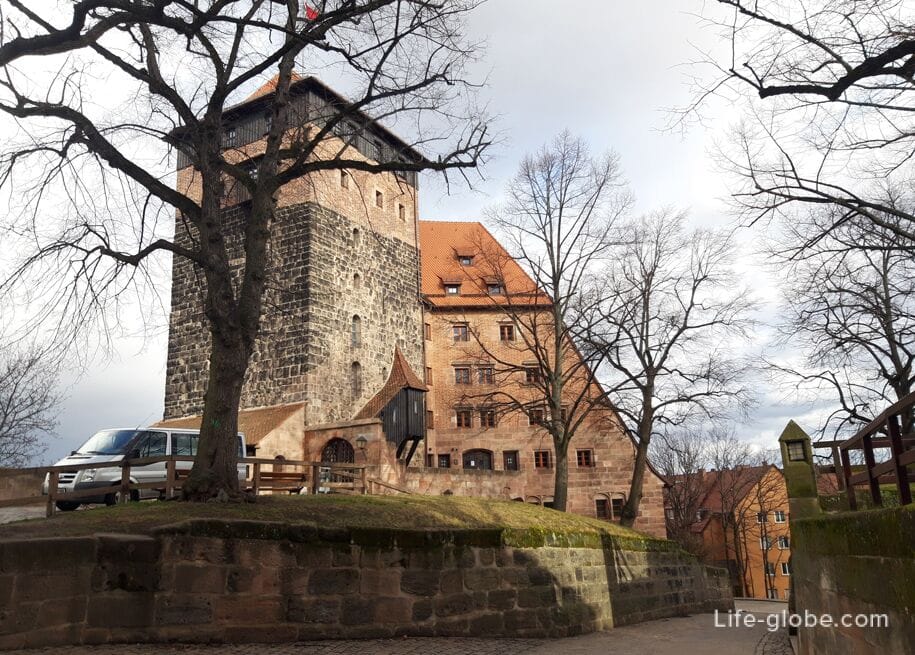
On Christmas Eve in Nuremberg workChristmas fairs (Nürnberger Weihnachtsmärkte), which are becoming one of the most visited and lively places in the city.
The Nuremberg Christmas markets are considered one of the most beautiful and colorful in Europe. About 2 million people visit Nuremberg during the Christmas fairs. Learn more about the Christmas markets in Nuremberg...
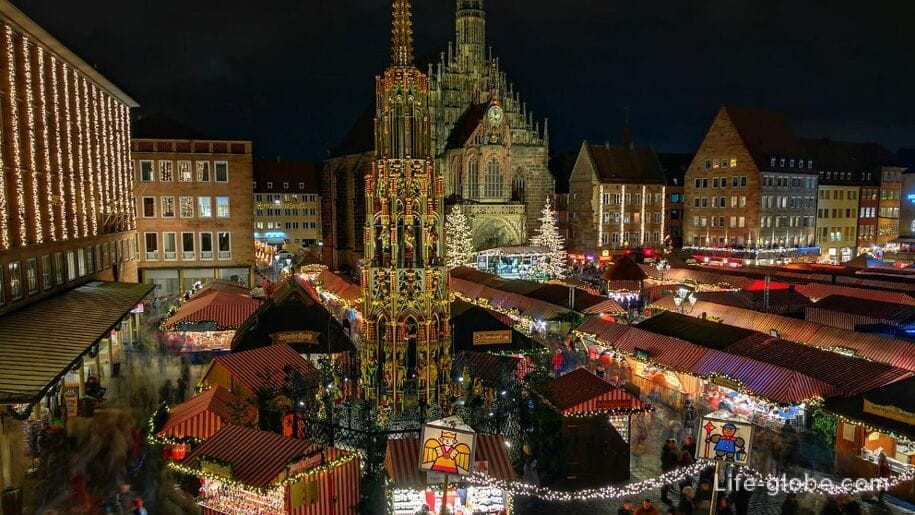
The Old Town of Nuremberg is the heart of the city and the place where the main tourist life takes place.
Nuremberg's main attractions are located in the old town and there are historical architectural monuments, including a fortress on a rock, half-timbered houses, elegant fountains, Gothic churches, town halls, museums and medieval dungeons, which are guided tours. And the city itself is almost completely surrounded by a former fortress wall with fortifications.
Also, the old city of Nuremberg is distinguished by paved streets, some of which are pedestrian; small but cozy squares; an abundance of cafes, bars and restaurants, there are taverns and summer beer gardens; souvenir shops, shops and small shopping centers. Accommodation facilities (hotels, apartments) are also located in the old town
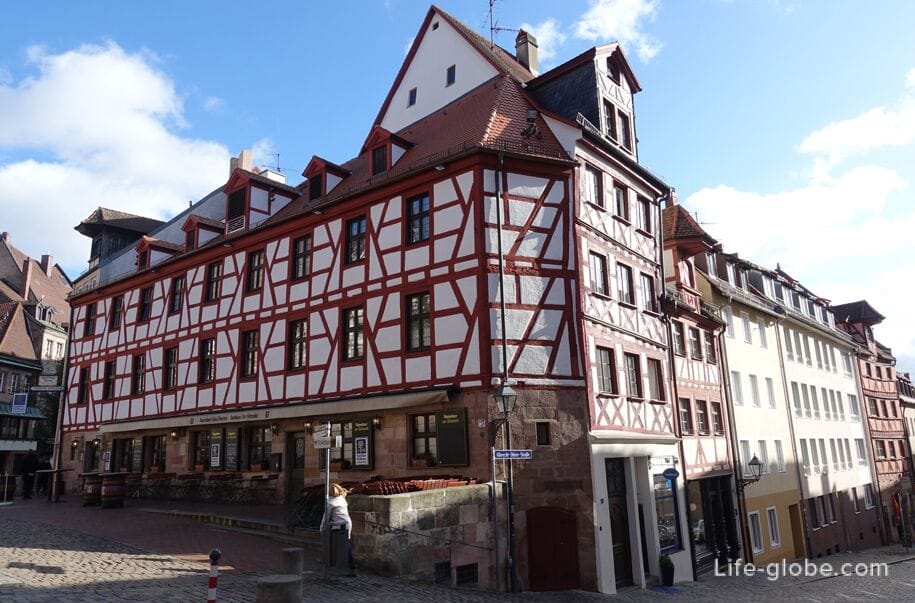
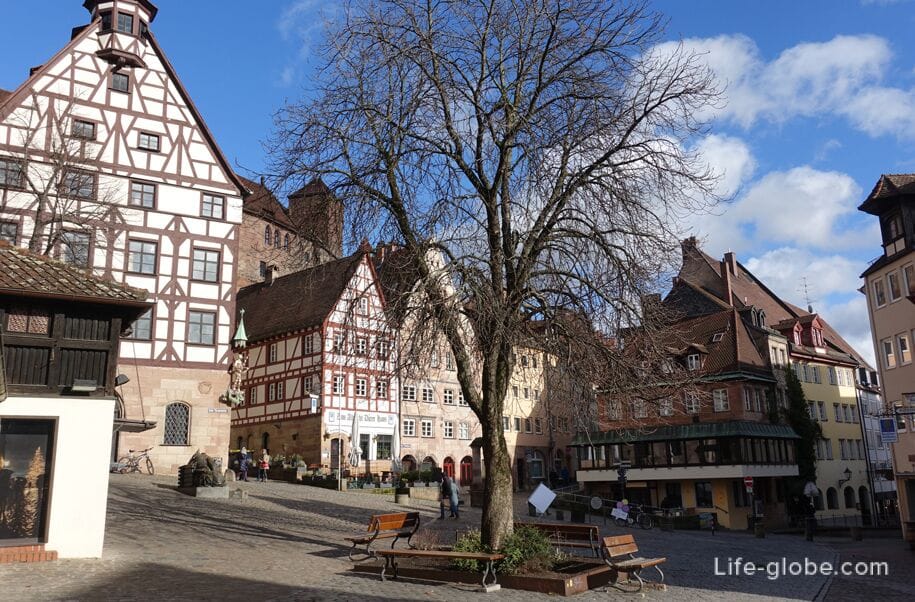


The main attractions and museums of the old town include
The last city wall with fortifications surrounding the current old city of Nuremberg was built by 1400 and had a length of 5 kilometers.
Today, the fortress wall of Nuremberg is one of the most important artistic and architectural monuments in the city. There are gates and towers in the wall, some of which are used by organizations and individuals. Behind, on and in front of the wall, as well as in the moat that has been preserved in places, now there are mainly pedestrian paths available for public use, and the moat itself is largely designed as a park. The former bastions to the west and north of Nuremberg Castle are arranged as a castle garden and are usually accessible during the warmer months. Learn more about the Nuremberg wall and fortifications...
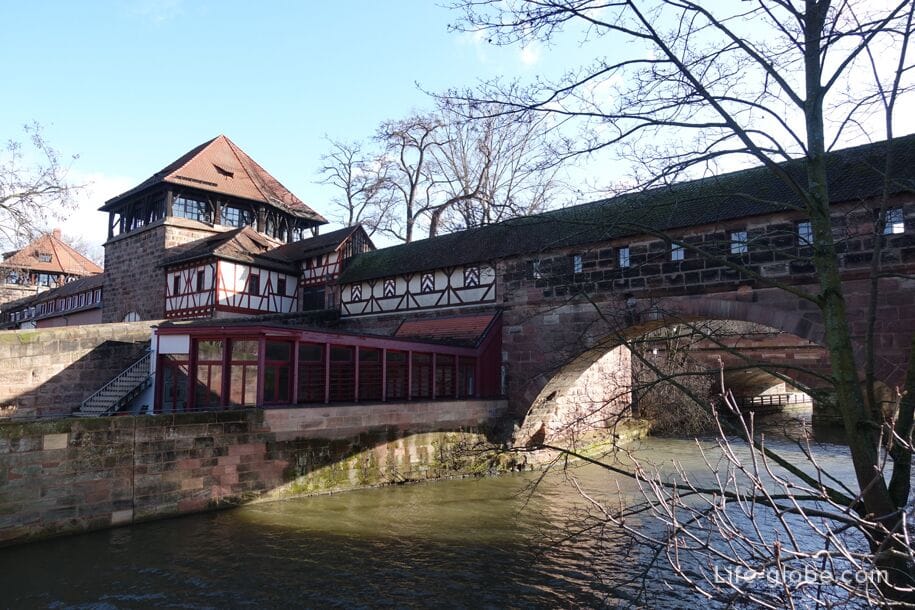
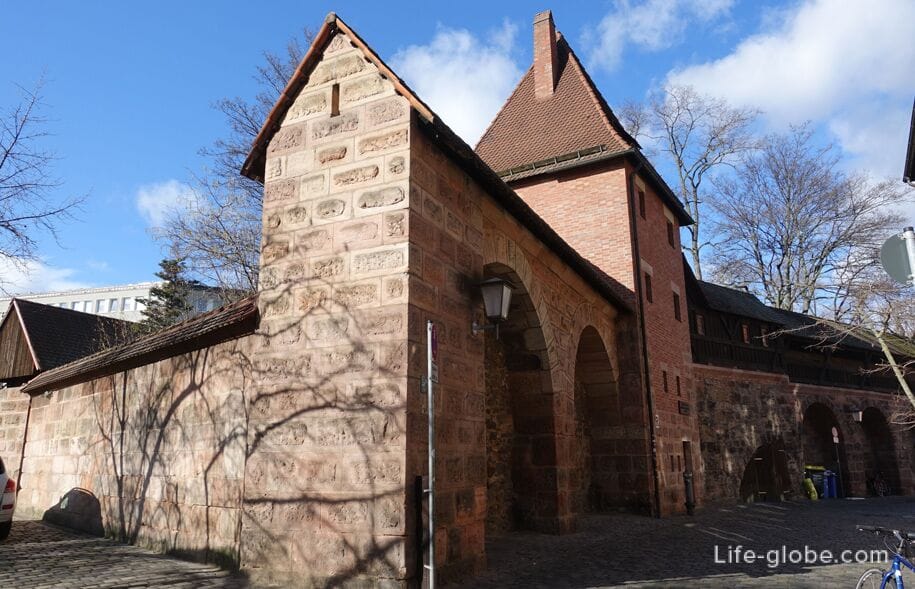
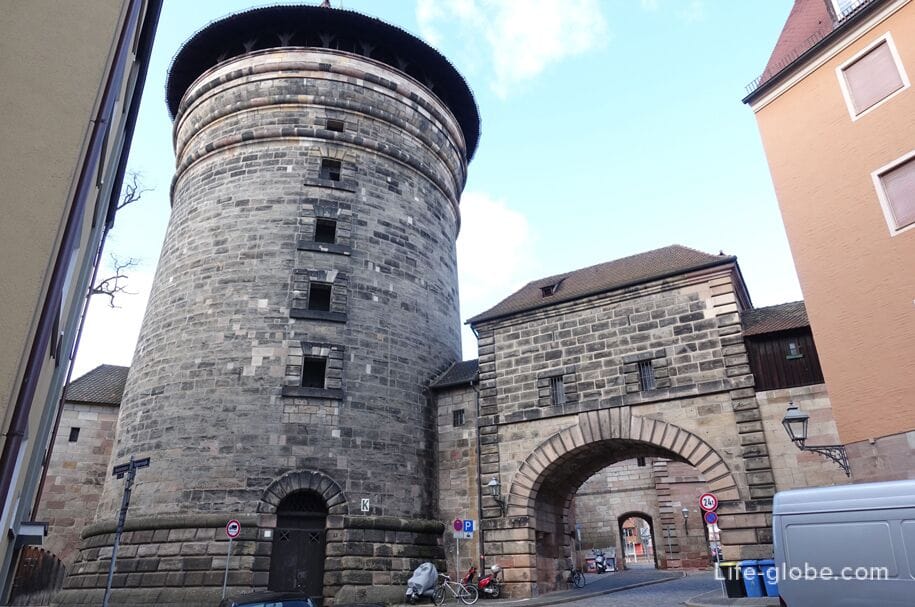
The Pegnitz River is the city river of Nuremberg and flows through the entire city.
The most famous part of the Pegnitz River flows in the historical center of Nuremberg and divides the old town into two halves of almost the same size: the northern Sebald (Altstadt - Sankt Sebald) and the southern Lorenz (Altstadt - Sankt Lorenz).
Embankments run along the river in the old town, historical buildings are located, and the river itself is crossed by bridges that have been part of the urban landscape since the Middle Ages.
Of the most significant bridges over the Pegnitz, one can distinguish: Museum Bridge (Museumsbrücke), (Fleischbrücke), Hangman's Bridge (Henkersteg) and Chain Bridge (Kettensteg). Learn more about the bridges and embankments of the Pegnitz River in the old town of Nuremberg...
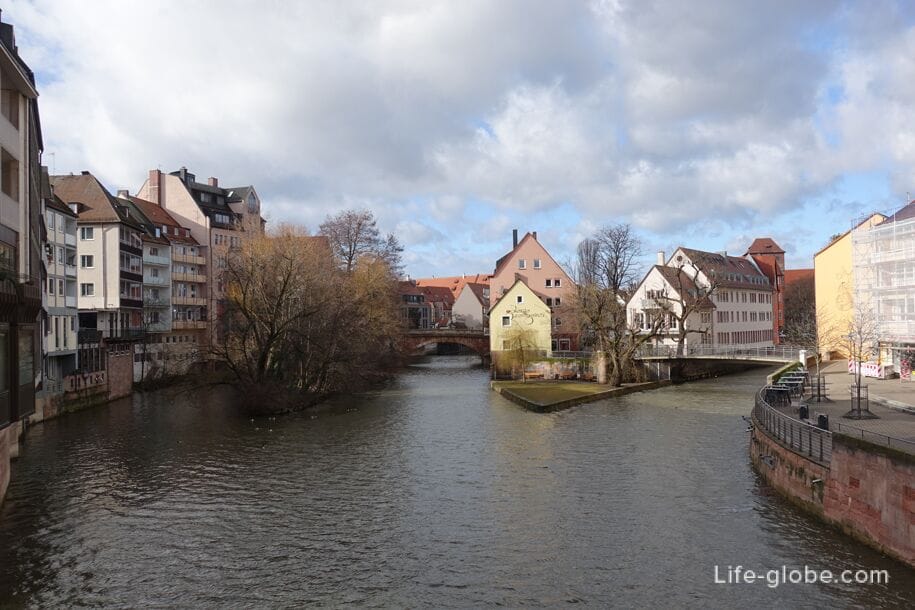
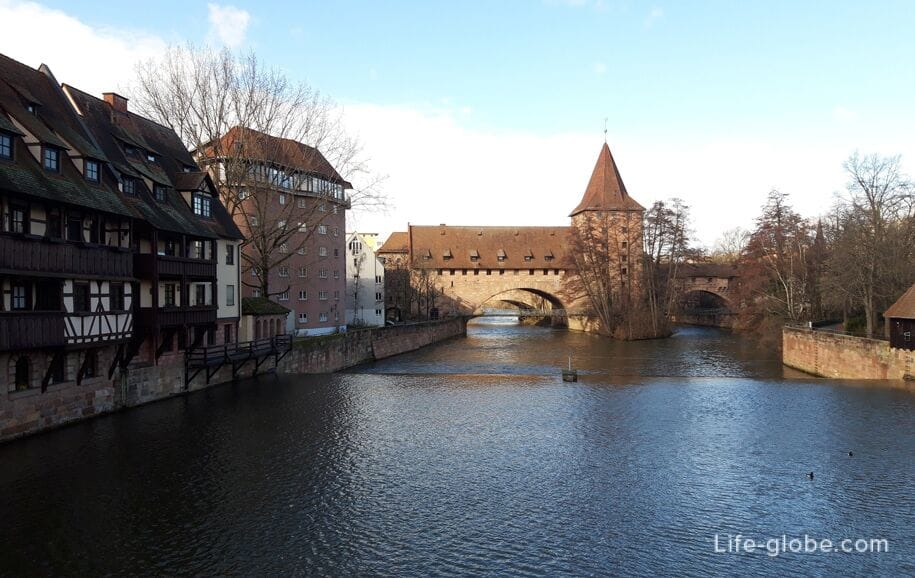
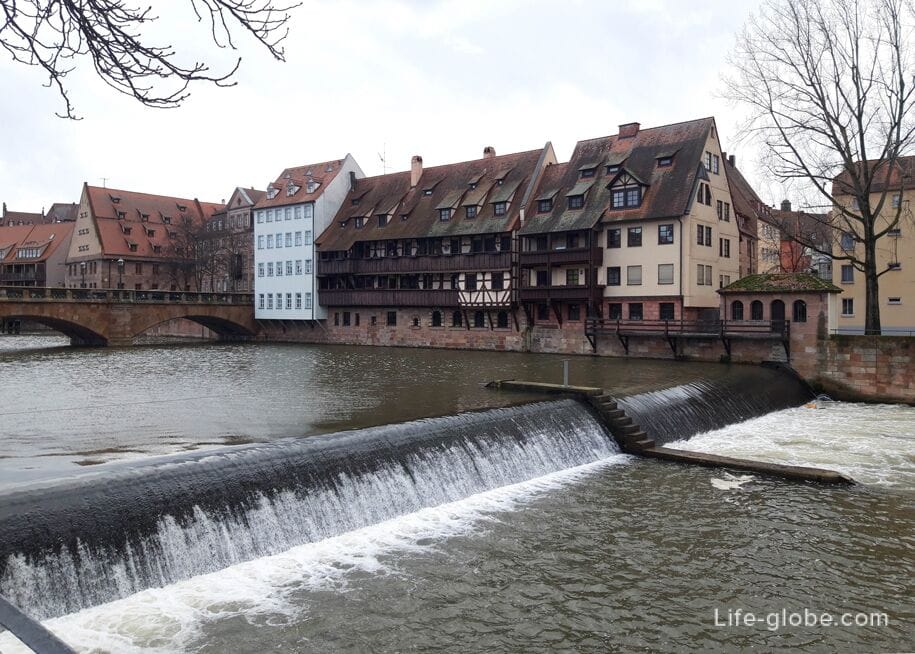
St. Lawrence Church (Lorenzkirche / Lorenzkirche) is one of the first churches in Germany to become Lutheran (since 1529).
The construction of the church took place in the period, presumably between 1243 and 1315, on the site of a former chapel in the Romanesque style. Subsequently, the church was expanded.
Today, the Gothic Lorenzkirche is one of the most outstanding buildings in Nuremberg.
The interior of the three-nave church impresses with its rigor and abundance of details. Powerful columns with arched ceilings complement the overall Gothic ensemble.
Church address: Lorenzer Platz, 1.
Website: lorenzkirche. More about the Lorenz Church...
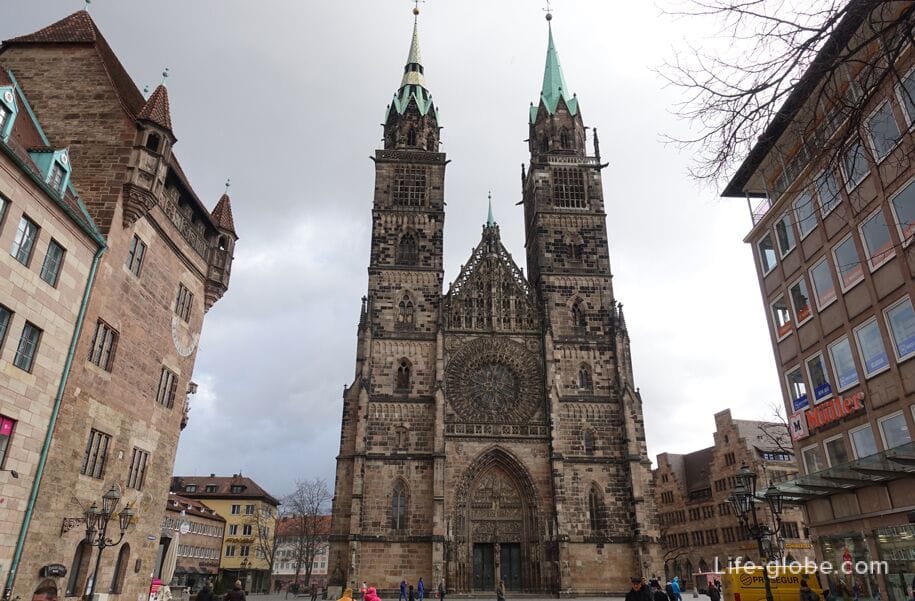
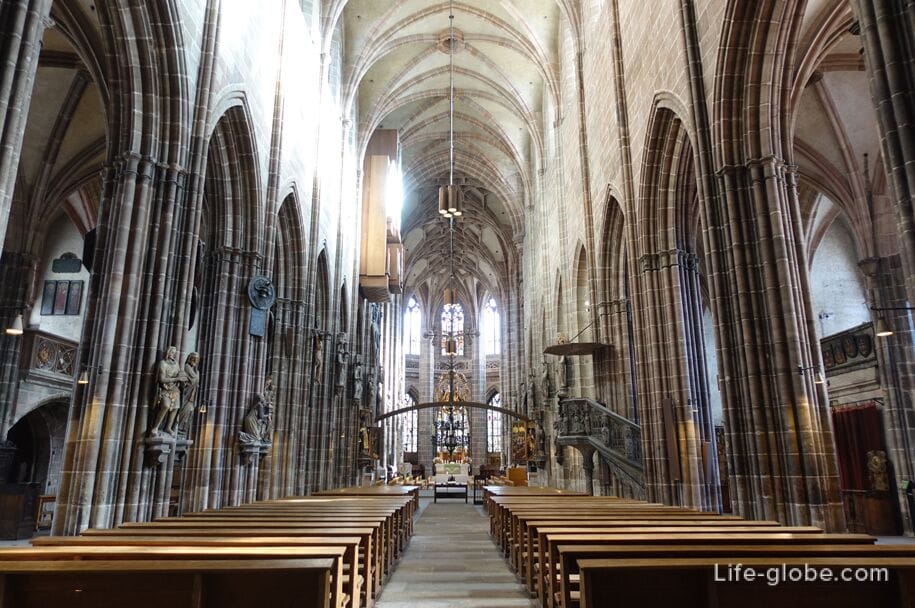
The Nassau House, also known as the Schlusselfelder Foundation House (Schlusselfeldersche Stiftungshaus) is a medieval residential tower, which is the only surviving residential tower in Nuremberg, and is considered one of the few examples of Romanesque architecture in the city.
The Nassau House has a corner location and is built in a row with other buildings. It is made of red sandstone on the model of northern Italian residential towers. It has four floors and a gallery, which is crowned by a high roof.
Address of the house of Nassau: Karolinenstraße, 2. More about the House of Nassau...
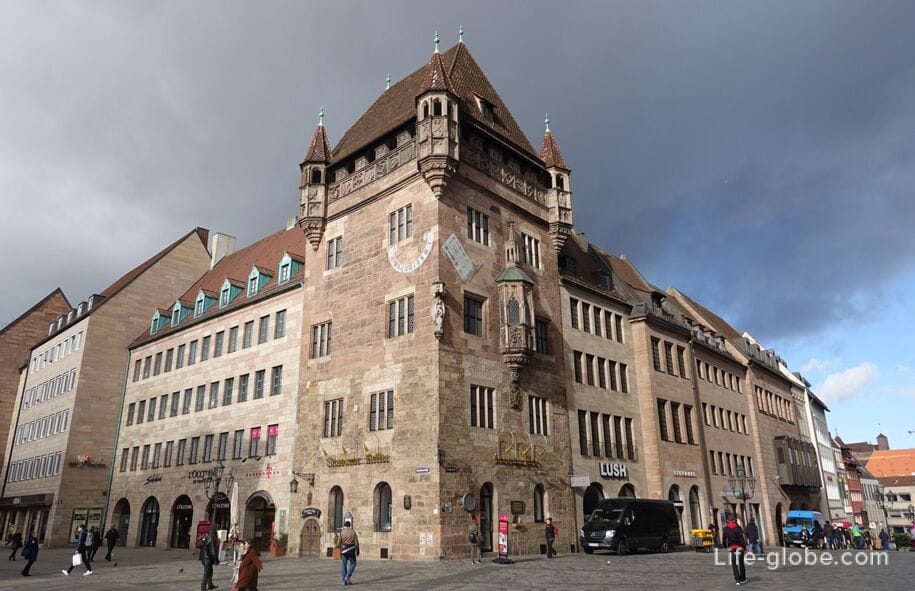
The fountain "Marriage Carousel" (Ehekarussell / Ehebrunnen) is a large-scale architectural fountain built in 1984.
The large sculptural composition of the fountain, made of bronze and marble, which is placed in the marble bowl of the fountain, represents six sculptural groups dedicated to and illustrating the images of the work of the German Meistersinger and playwright Hans Sachs (16th century) - "Bittersweet Family Life", written for his wife.
The sculptural pedestal depicts Hans Sachs himself, in a dancing pose.
The fountain is located on Ludwigsplatz Square. More about the fountain "Marriage carousel"...
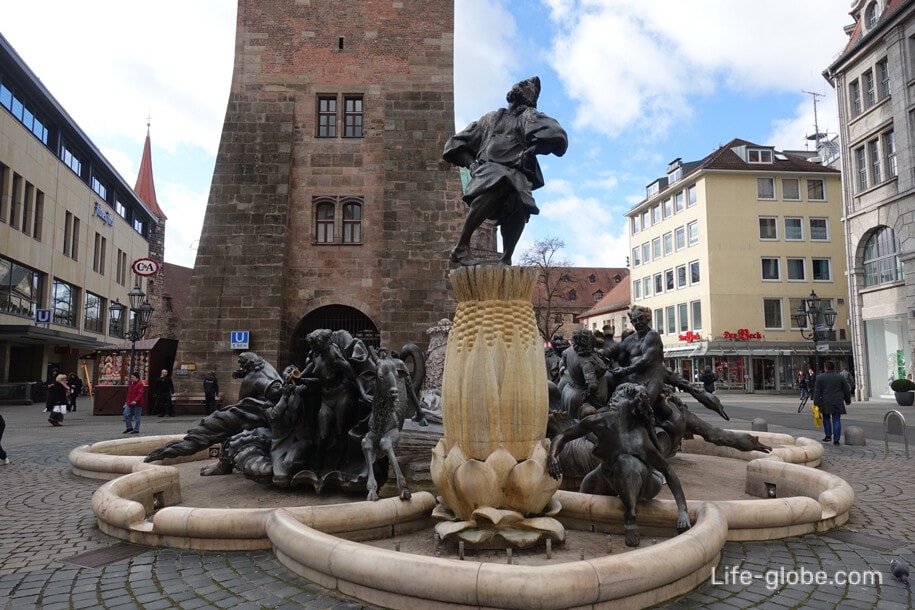
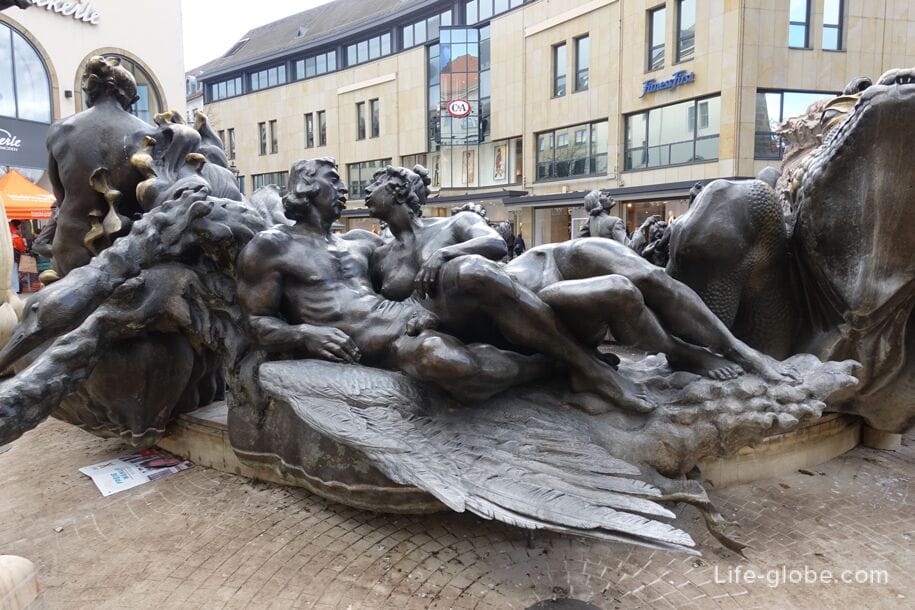
The White Tower (Weißer Turm) is a historical tower that was part of the penultimate city fortifications of Nuremberg, and was also the gateway to the city.
The tower was erected around 1250 and served for the defense of the gate.
The tower is a block structure of brick and sandstone with a pointed archway and alternative niches. There is a barbican on the southwest side of the tower. In the upper parts of the tower, on the south-western and north-eastern sides, there is a clock. On the north-eastern side of the tower, facing the old town, there are coats of arms, including the city of Nuremberg.
The White Tower is located on Ludwigsplatz Square. Learn more about the White Tower...

The Human Rights Street or the Human Rights Road (Straße der Menschenrechte) is a monument in the form of a monumental sculptural composition located outdoors on Kartäusergasse Street.
On the street, the entrance three-arched gates and a sculptural composition dedicated to the "Universal Declaration of Human Rights" are noteworthy and, according to the Nuremberg Human Rights Office, is "both an accusation of the crimes of the National Socialists and a reminder that human rights are still massively violated in many countries of the world." Learn more about Human Rights Street...
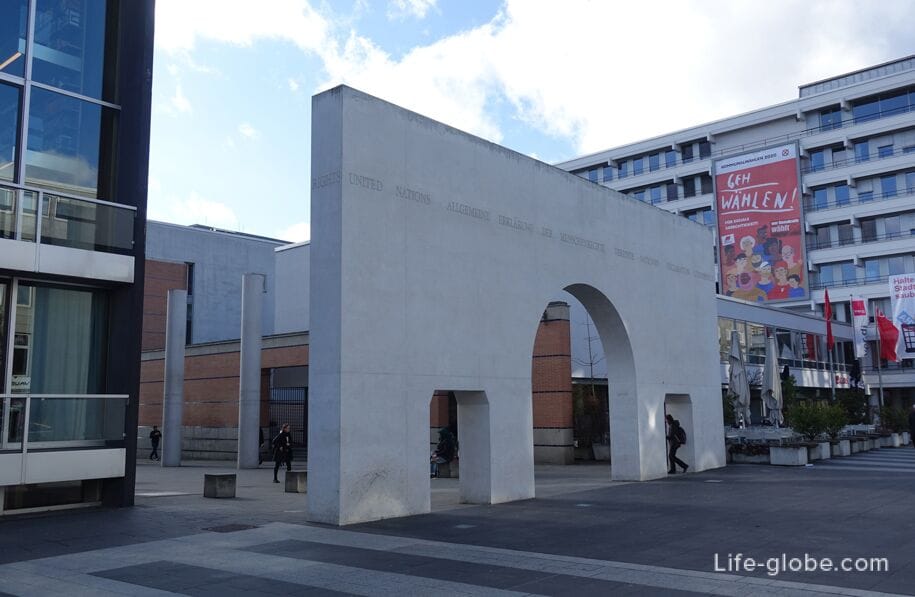
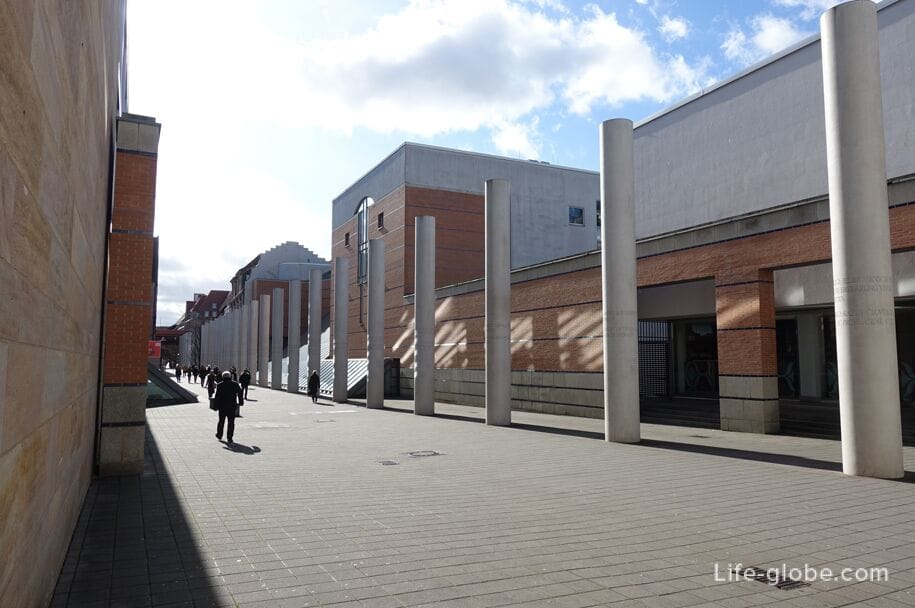
The eastern side of Human Rights Street is occupied by buildingsThe German National Museum (Germanisches Nationalmuseum) is the largest museum of the cultural history of German-speaking regions in Germany.
The museum's collections showcase the history, culture and art of the regions where German is spoken or was once spoken, from prehistoric times to the present day.
The buildings of the museum represent an ensemble, part of which forms the former Carthusian monastery, and part - more modern buildings.
The museum's website: gnm.de . More about the German National Museum...
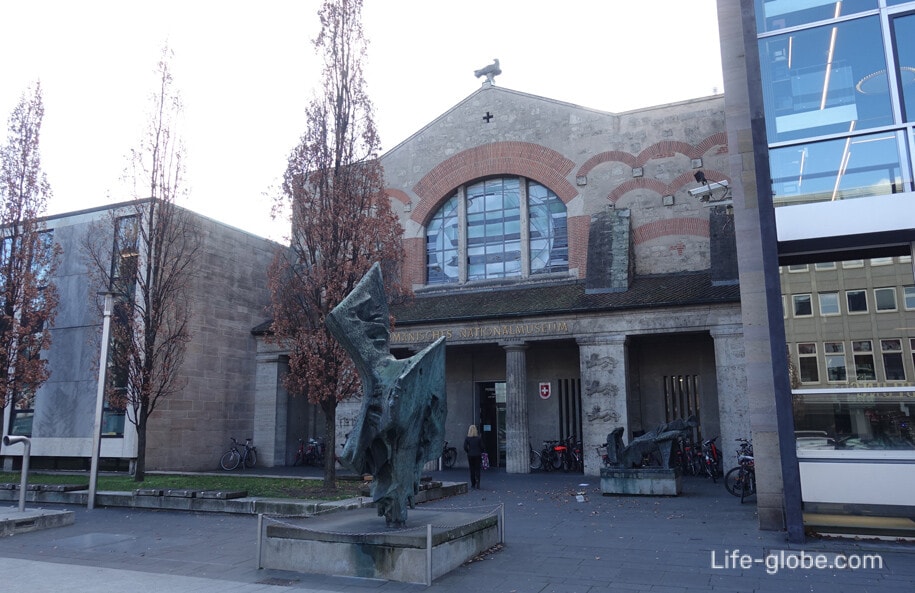

The Debtors' Tower or Debt Tower (Schuldturm) is a historical tower, which, presumably, was part of the penultimate city fortifications, and was built in 1323.
After its construction, the tower was located within the city, and it was turned into a prison for debtors, and also used as so-called stupid houses for the mentally ill.
The tower is located on the Insel Schütt Island on the Pegnitz River. More about the Debtors' Tower…
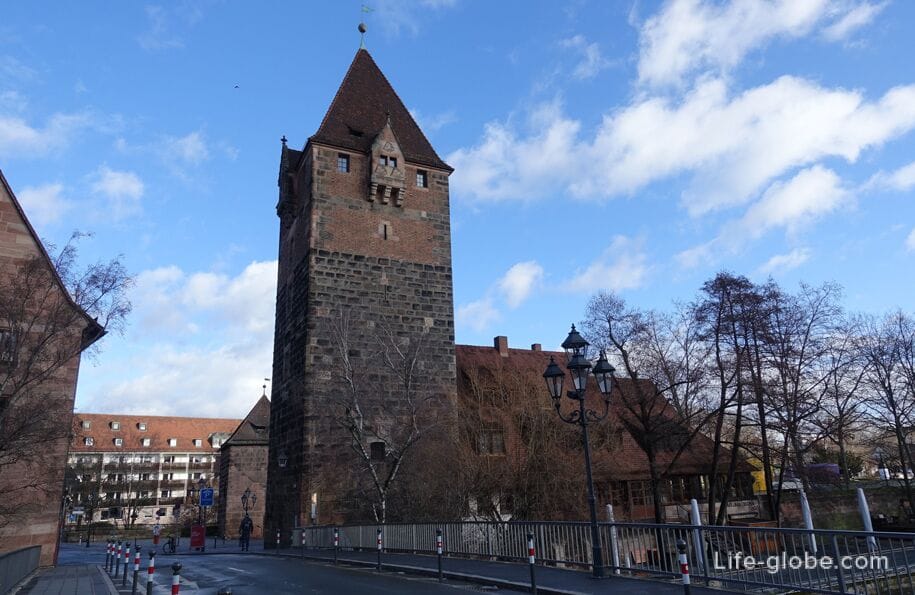
The Hospital of the Holy Spirit (Heilig-Geist-Spital) is the oldest and once the largest medical institution in Germany.
The hospital was built in 1332-1339 together with the church. The infirmary, as in many medieval cities, was dedicated to the Holy Spirit.
The walls of the hospital now house a nursing home and a restaurant "Heilig-Geist-Spital Nürnberg", with tables in the courtyard.
Due to the fact that the wing of the hospital is located above the waters of the river, and its arches are lowered into the water, locals also call the hospital "Nuremberg Glasses". Also noteworthy is the restored picturesque bay window with a pointed tower.
The hospital is located on the bow of the island of Schuette, at the address: Spitalgasse, 16. More about the Hospital of the Holy Spirit...
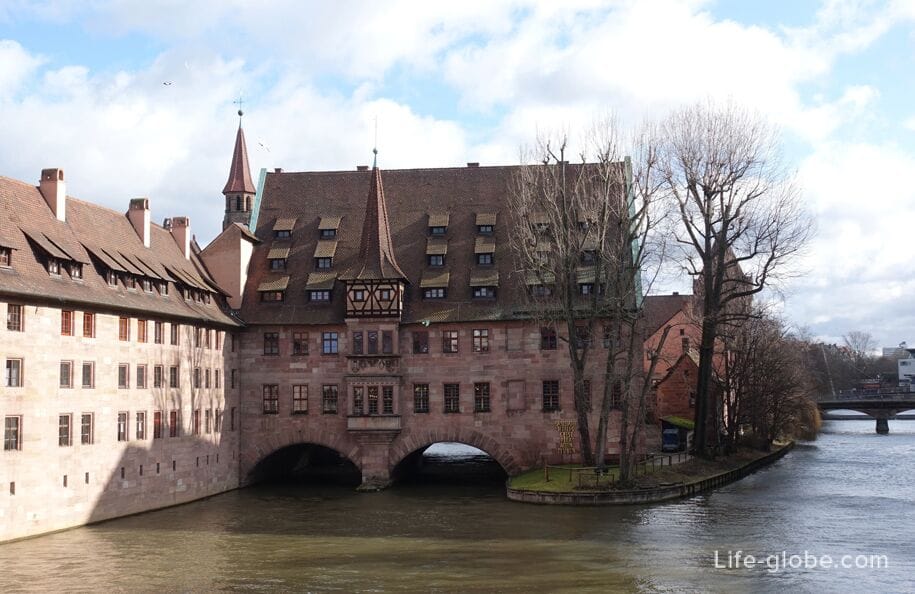
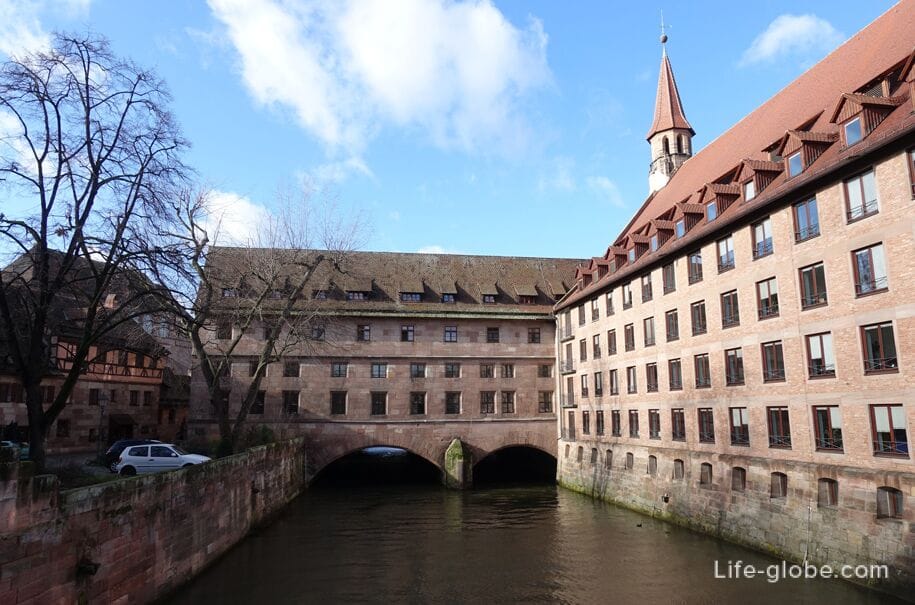
Hangman's bridge (Henkersteg), round tower on the wall of the Executioner (Henkerturm) and half-timbered building of the former wine warehouse (Weinstadel) are one of the most recognizable and visited architectural ensembles of Nuremberg, which, in addition to these buildings, also includes: square water tower (Wasserturm), dwukrotny the connecting bridge (Pesnicky bridge / Pegnitzüberbrückung).
This "magnificent six" is a single, one of the most famous, photographed and, without a doubt, impressive architectural ensemble of Nuremberg.
The ensemble is located on the western bow of the island "Flea Market" (Trödelmarkt) on the Pegnitz River. More about the ensemble...
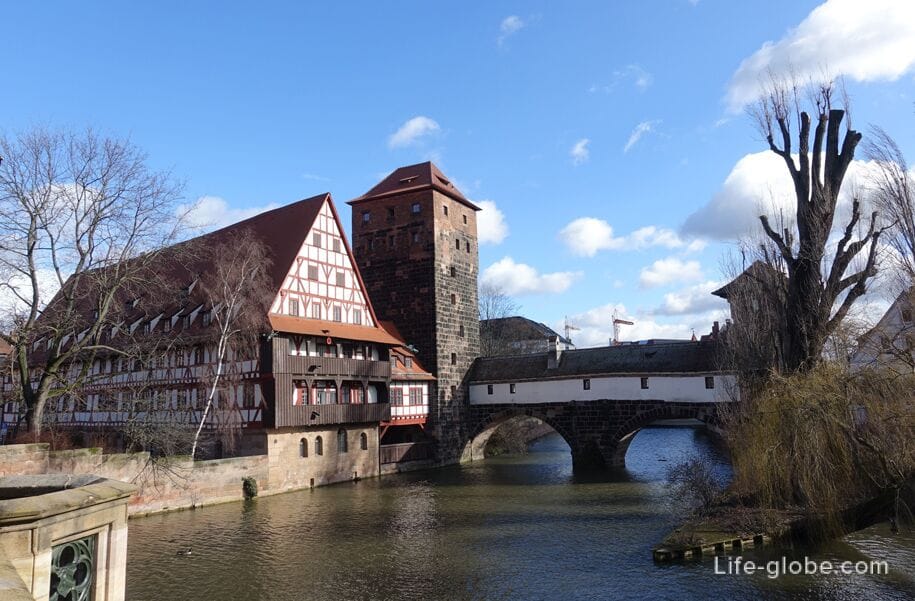

The main square of Nuremberg is the Market Square (Hauptmarkt / Hauptmarkt), which is almost entirely the pedestrian center of the city and a place where something is constantly happening - whether it's the weekly market or the main Christmas market of the city. More about the Market Square...
On the Market Square are notable:
- A beautiful fountain or a Beautiful fountain (Schöner Brunnen / Schoener Brunnen), built between 1385 and 1396 from sandstone.
Today on the Market Square there is a colorfully painted copy of the shell-stone fountain (1903). More about the Beautiful Fountain...
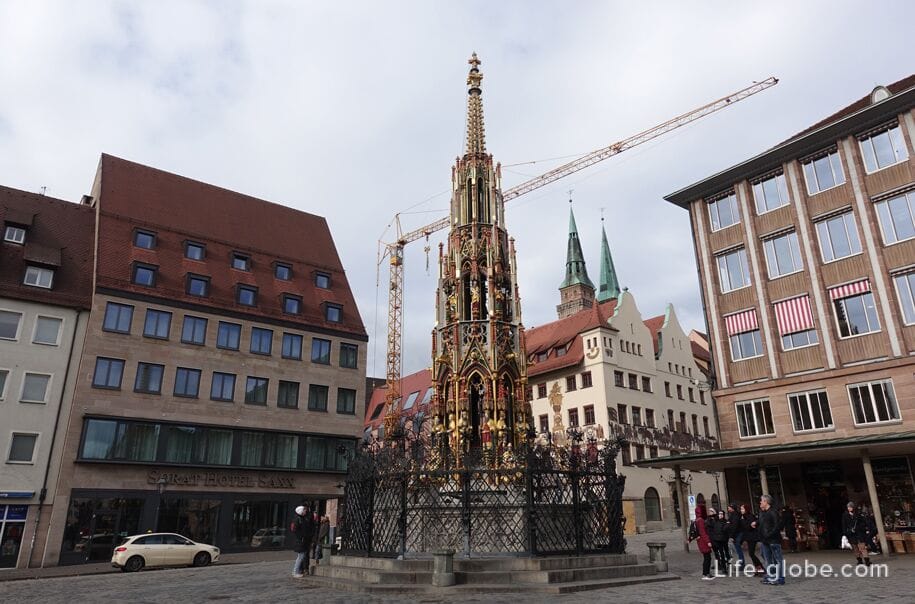
- The Church of the Virgin Mary or Frauenkirche, which is the main dominant of the square and was built as an imperial court chapel and a hall church building from 1352 to 1362 on the initiative of Emperor Charles IV. More about the Frauenkirche...
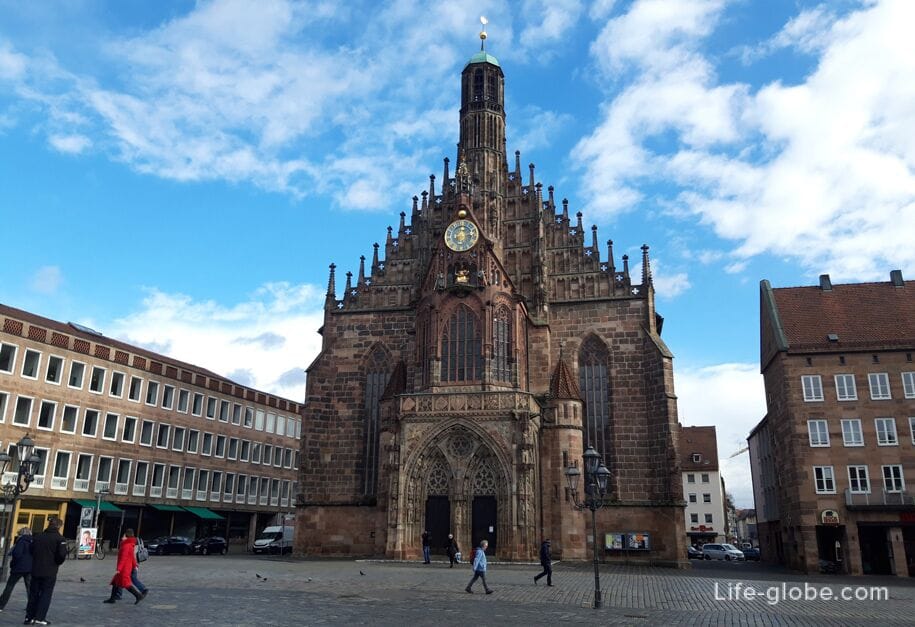

- the ensemble of Nuremberg Town Halls, consisting of the Old Town Hall and the New Town Hall.
The Old Town Hall (Altes Rathaus) consists of two parts: the oldest part of the town hall - Gothic, built since the 14th century (between 1332 and 1340), and later, made in the style of the Italian Renaissance - built in the 17th century.
In the basements of the Old Town Hall there is a museum of medieval dungeons (Mittelalterliche Lochgefängnisse), which consists of a historical dungeon prison, the cells of which have been used since the 14th century for interrogations and detention of prisoners before the execution of sentences.
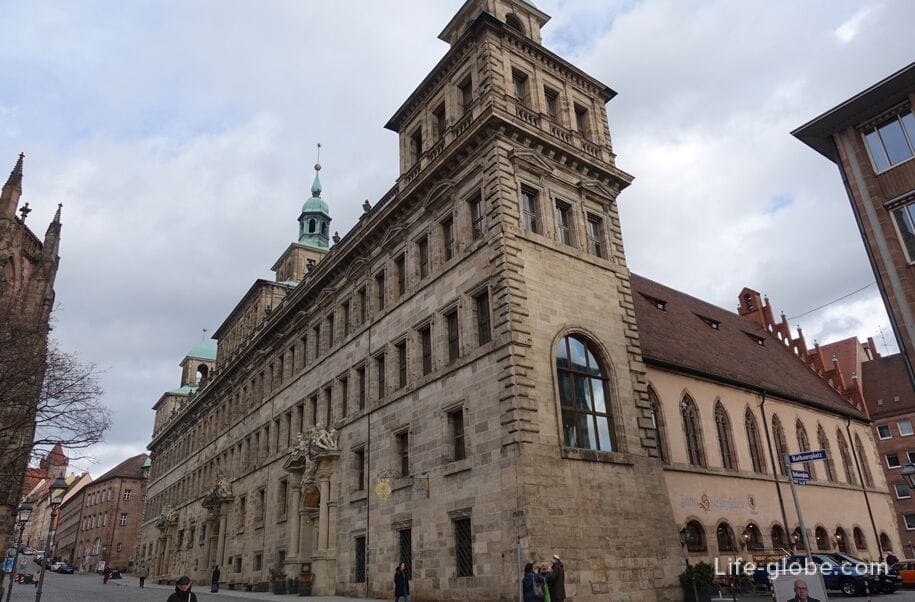
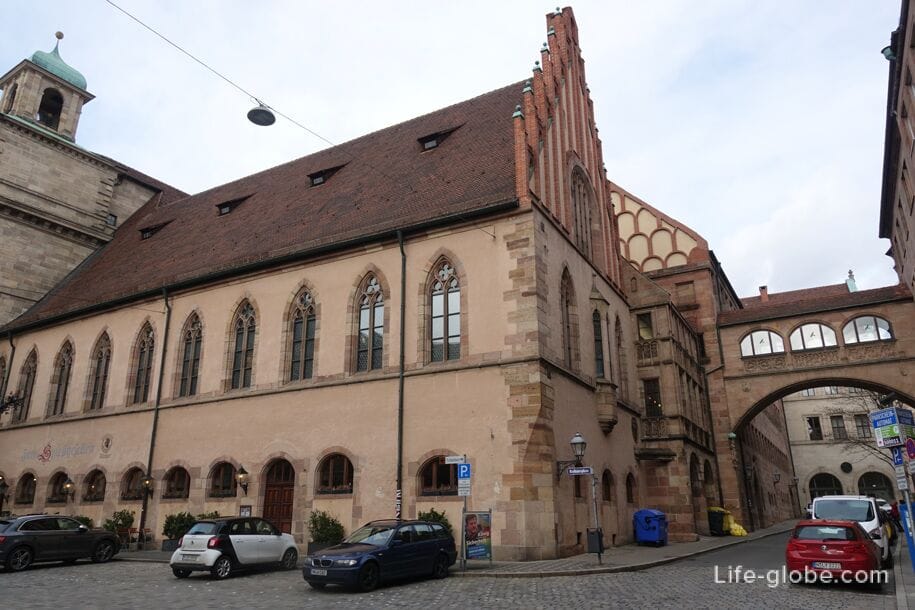
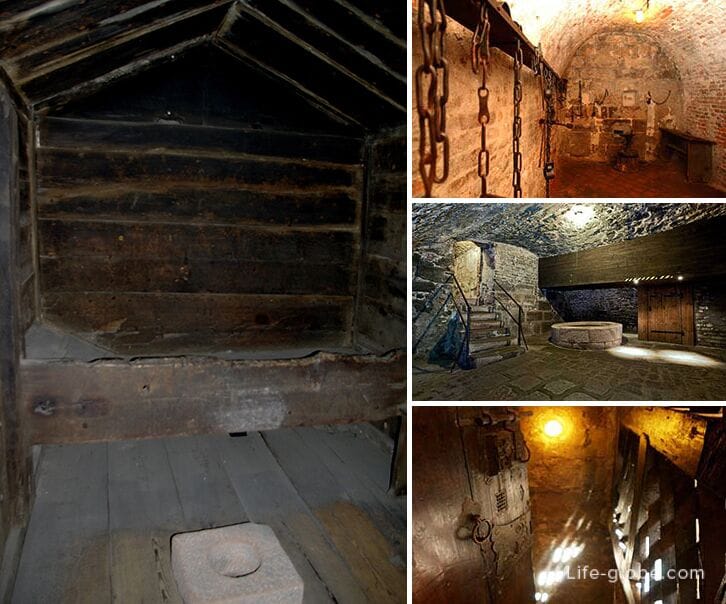
The New Town Hall (Neues Rathaus) is a detached building located on the south side of the Old Town Hall.
The construction of the town hall took place from 1954 to 1956. More about the town halls and the museum...
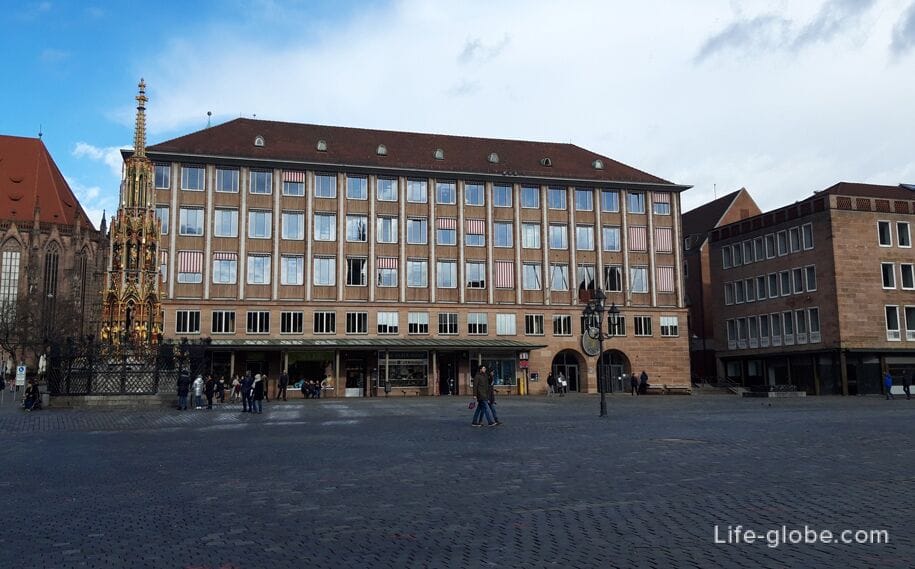
The Church of St. Sebald (Sebalduskirche) is the oldest parish church in Nuremberg and one of the most prominent church buildings in the city.
The construction of the Late Romanesque basilica with two choirs began in 1225-1230, on the foundation of the walls of the previous church, presumably dedicated to St. Peter.
By 1379, the side aisles of the church were expanded, the towers were raised in the high Gothic style and the altar of the late Gothic hall was built. Two towers were added in the 15th century.
Especially popular is the Schreyer-Landauer Epitaph, located near the northeast end of the building.
The interior of the church has three naves separated by powerful columns with arched ceilings.
The interior reflects more than seven centuries of faith and the history of Nuremberg art.
Church address: Winklerstraße,26.
Website: sebalduskirche. More about St. Sebald's Church...

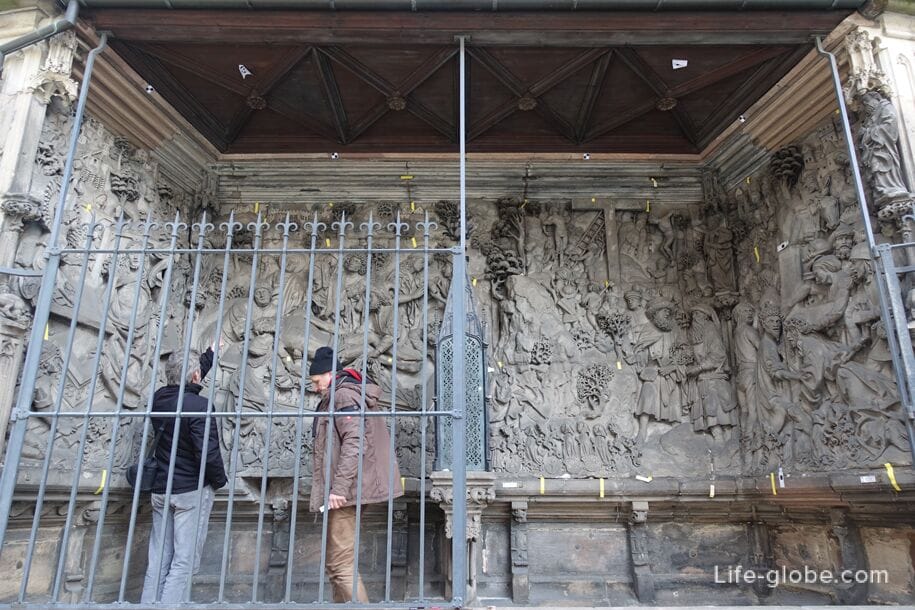
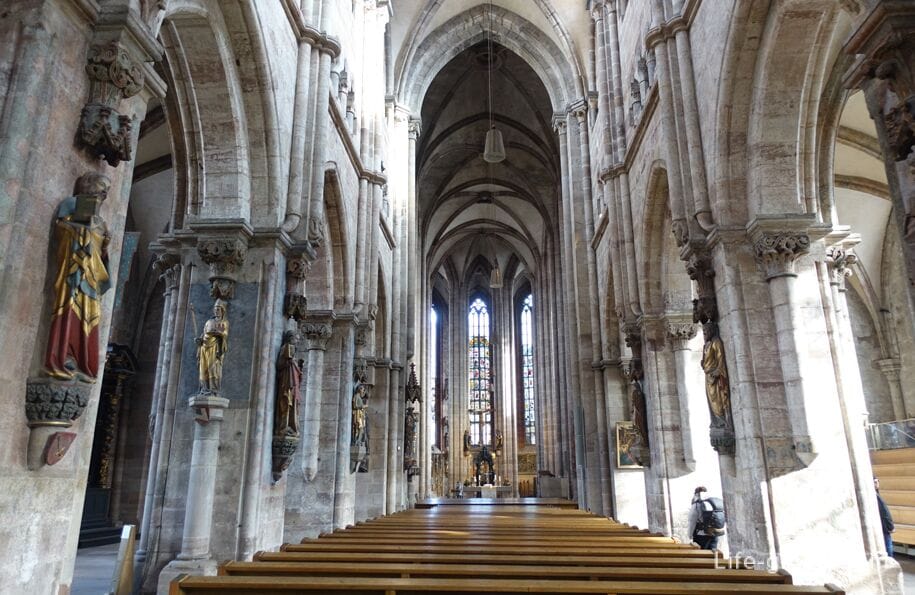
The Fembo House (Fembo-Haus) is the only surviving large merchant house of the Late Renaissance era in Nuremberg, within the walls of which the Nuremberg City Museum (Stadtmuseum) is now located.
The house was built in the period from 1591 to 1596 on the site of a previously existing building.
During its history, the house has changed several owners who have made their own changes to the interior of the building. The exterior of the house did not change.
House address: Burgstraße, 15.
Museum website: fembohaus. More about the Fembo House and the Nuremberg City Museum...
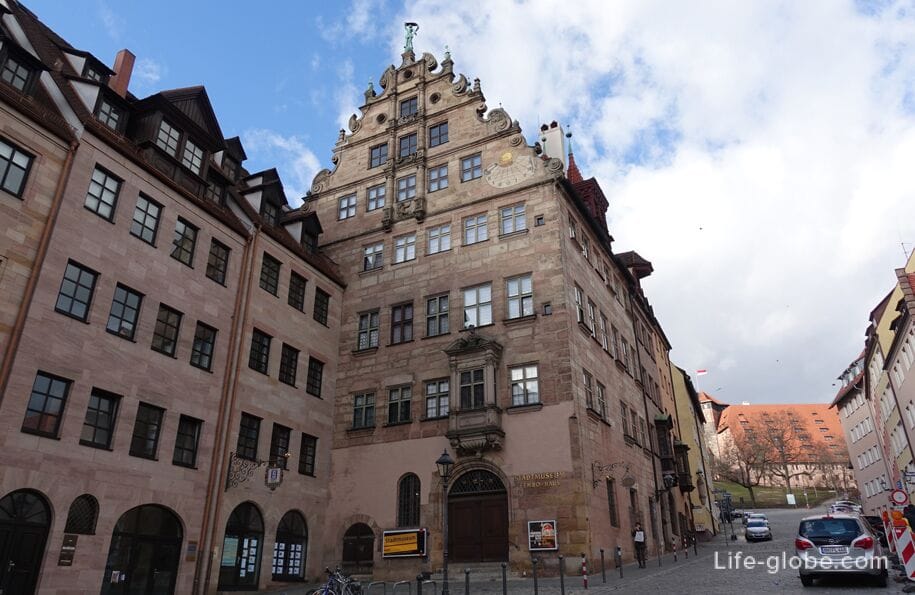
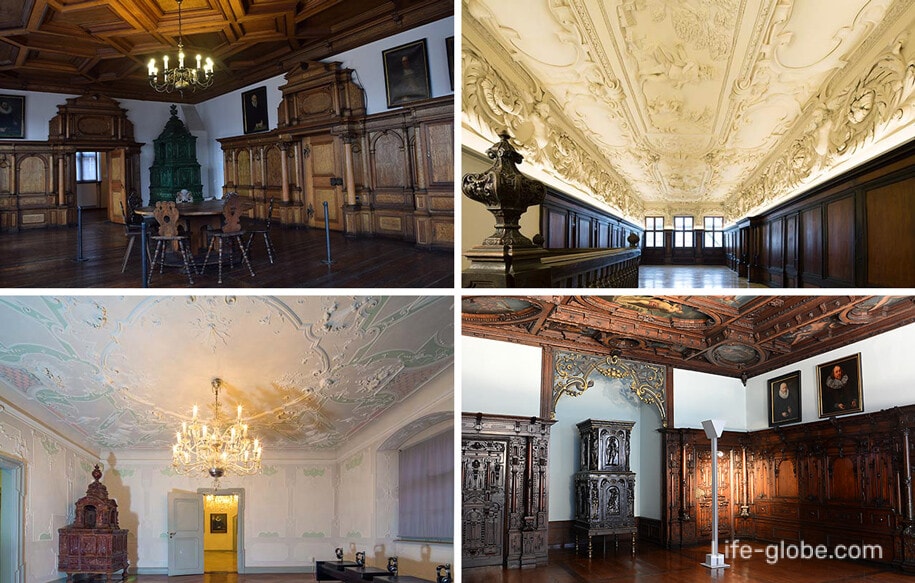
Nuremberg Fortress (Nürnberger Burg), also known as Kaiserburg Castle (Kaiserburg Nürnberg) - the former residence of the rulers.
Today, the Nuremberg Fortress is a symbol and the main attraction of the city. It is a group of medieval fortified buildings and is considered one of the most formidable medieval fortifications in Europe, which personified the power and importance of the Holy Roman Empire, as well as the outstanding role of the imperial city of Nuremberg.
Museums are located in part of the fortress premises.
The fortress is located on the rocky mountain "Nuorenberc".
The address of the fortress: Auf der Burg, 17.
Fortress website:kaiserburg-nuernberg. More about the Nuremberg Fortress...
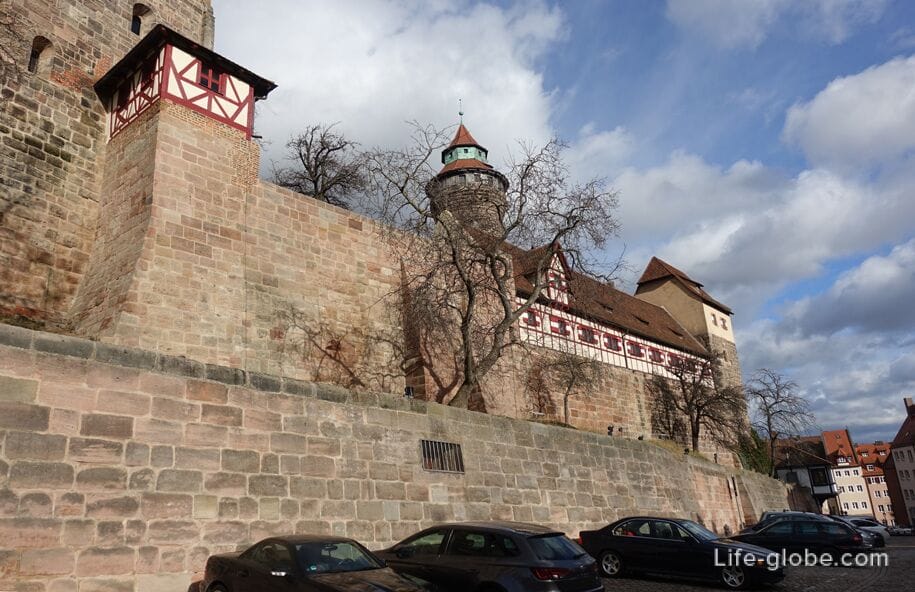
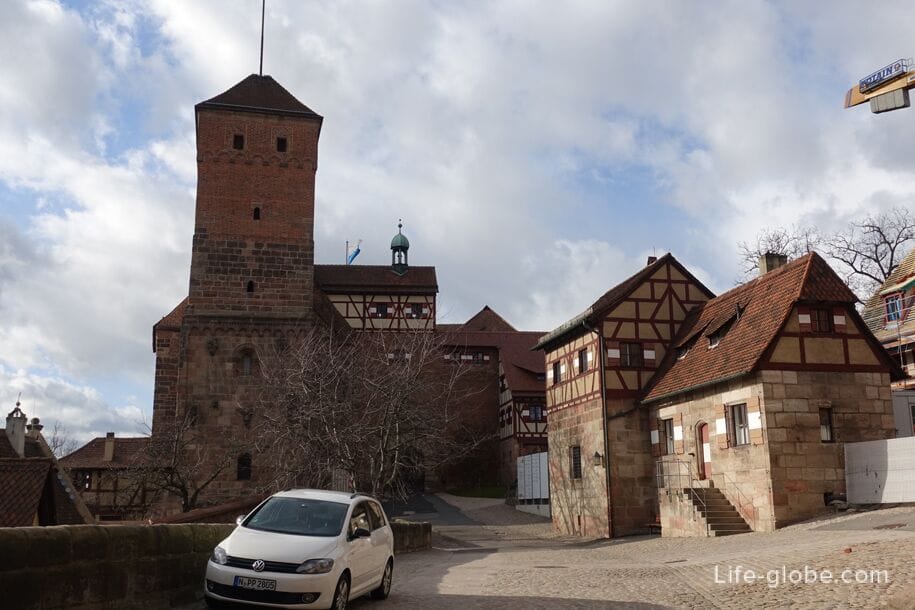
The Albrecht Dürer House-Museum (Albrecht-Dürer-Haus / Albrecht-Dürer-House) is a preserved half-timbered house built around 1420.
From 1509 until his death in 1528, Albrecht Durer (1471-1528), a German painter, engraver and graphic artist of the Renaissance period, lived and worked in the house.
Since 1871, the building has been a house museum dedicated to the life and work of Durer.
Address of the Durer House-Museum: Albrecht-Dürer-Straße, 39.
Website of the Durer Museum: duererhaus. More about the Durer House Museum...


Pilate's House (Pilatushaus) is a town house, which is one of the few surviving town houses in the late Gothic style and one of the most important architectural monuments of the old city of Nuremberg.
The house was built in 1489 and originally belonged to an armory blacksmith (Plattner) Hans Grunwald, who made knight's armor and equipment.
For this reason, the house was also called "the house of the man in armor". On the southeast corner of the building there is a statue of St. George, dressed in knight's armor and standing on a defeated dragon.
During the history of the building has often changed hands. Since 1931, the house belongs to the city of Nuremberg. Today the house is used for temporary exhibitions of contemporary art.
Pilate's House is located on Tiergärtnertorplatz. More about Pilate's house...
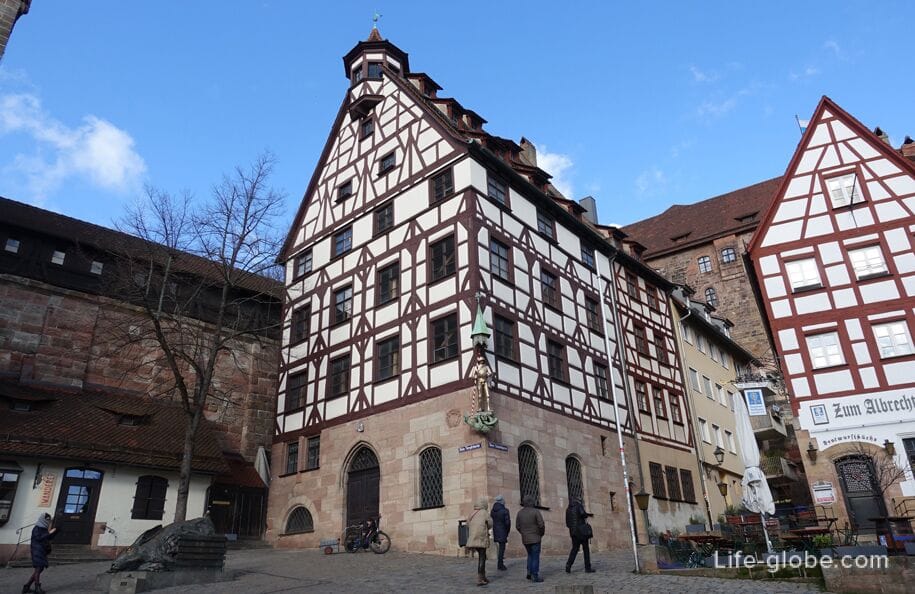
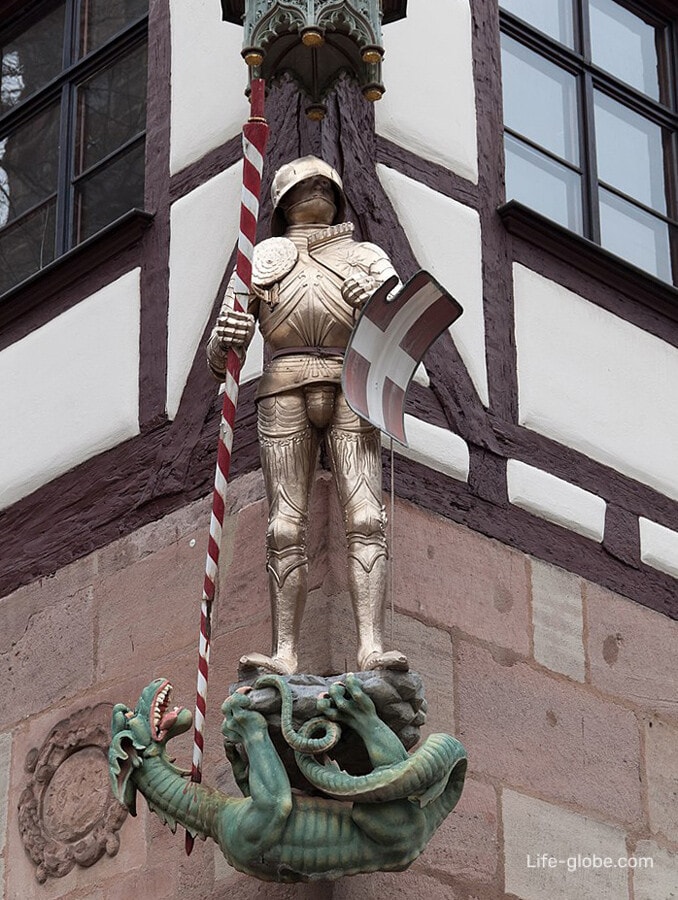
Near Pilate's house there is a sculptural composition "Durer's Hare" (Dürer-Hase Skulptur), created in 1984 by the German sculptor Juergen Goertz (Juergen Goertz) as a tribute to Albrecht Durer.
The sculptural composition consists of two groups:
- in the upper part of the composition, on a pedestal, there is a bronze sculpture of a huge hare, which looks more like a mutant and gets out of a wooden box;
- on the second, smaller pedestal, there is a bronze sculpture of a small and cute bunny. More about the sculpture "Durer's Hare"...
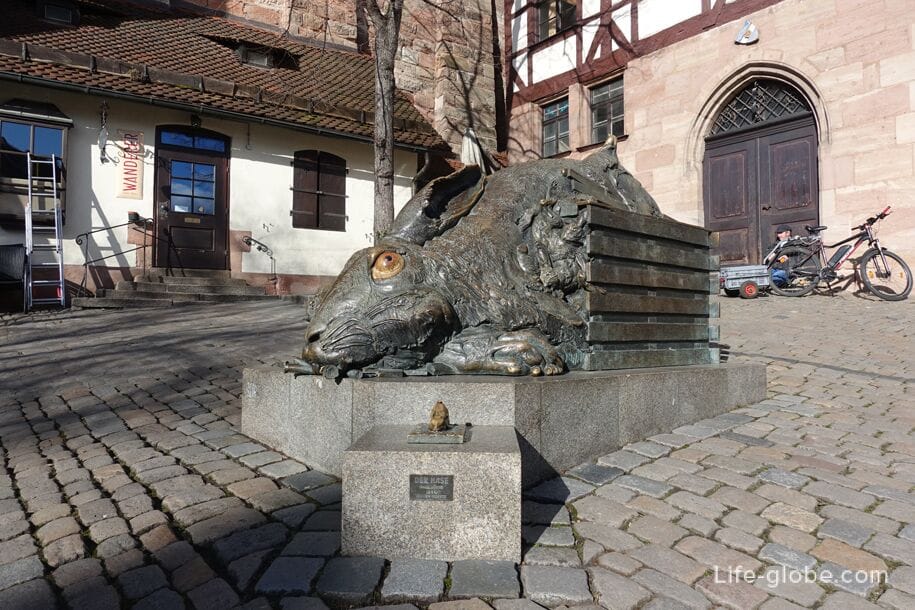
The entrance to the museum "Bunker of Historical Art" (Historischer Kunstbunker / historical Kuntsbunker) is through an unremarkable building. However, the museum itself is located in a rock under the Nuremberg Castle - a former beer cellar, in which, at a depth of up to 24 meters, during the Second World War, Allied troops discovered a Nazi bunker-cache with art objects and valuables taken from the occupied territories.
The museum offers guided tours of the Nuremberg dungeons.
Museum address: Obere Schmiedgasse, 52.
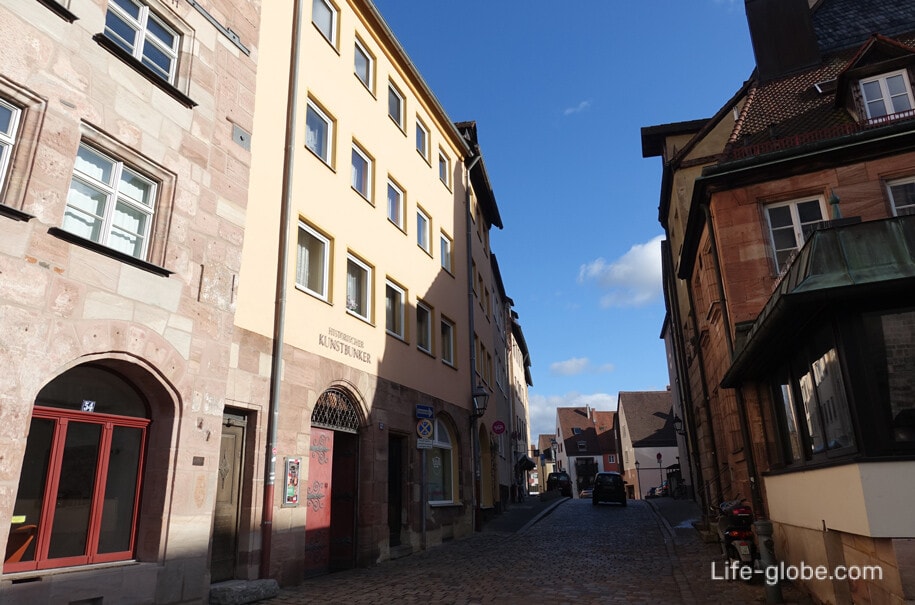
In addition to the bunker of historical art, other excursions to the dungeons (casemates) are held in the old city of Nuremberg.
In the Middle Ages, passages and rooms were laid under the Nuremberg fortress, bastions and defensive city wall (since 1545) - the so-called casemates (Kasematten) and rock passages (Felsengänge).
During the history of the casemates were used for various purposes: as hidden passages, emergency exits, a secret system of water pipes, beer cellars (warehouses for beer) and even as a prison.
Today there are guided tours of the casemates.
Website: felsengaenge-nuernberg. The site contains information, including about excursions to the historical bunker.
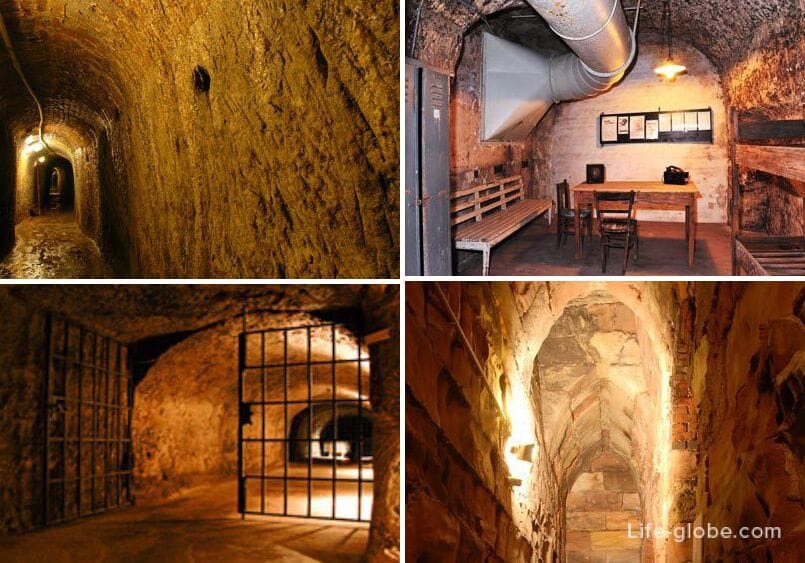
Weißgerbergasse is one of the most beautiful streets in Nuremberg, along which there are historical buildings, including half-timbered houses.
The name of the street comes from white tanners (Weißgerbern) who lived and worked in houses on the street in the Middle Ages.
More than twenty medieval artisan houses survived during the Second World War. Subsequently, they were carefully restored. More about Weissgerbergasse street...
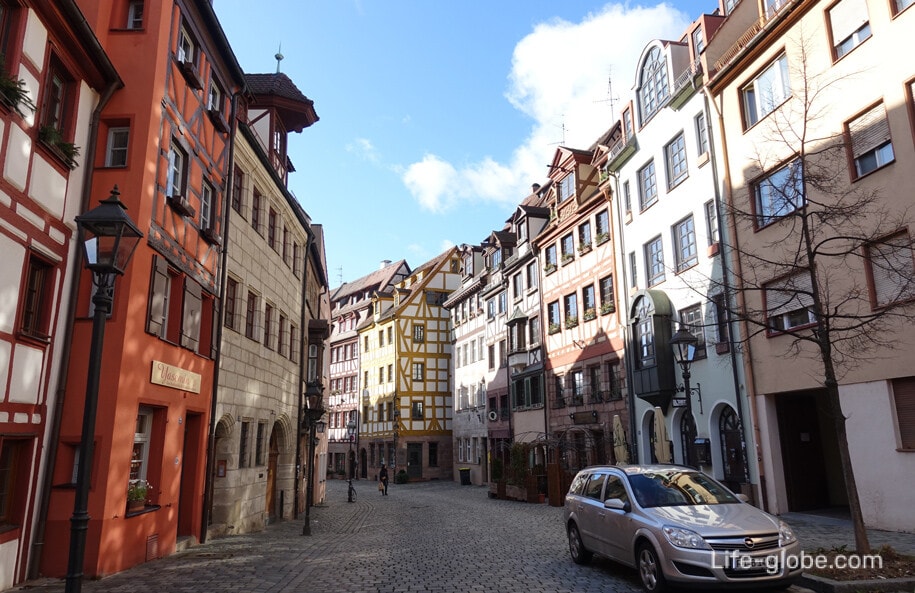
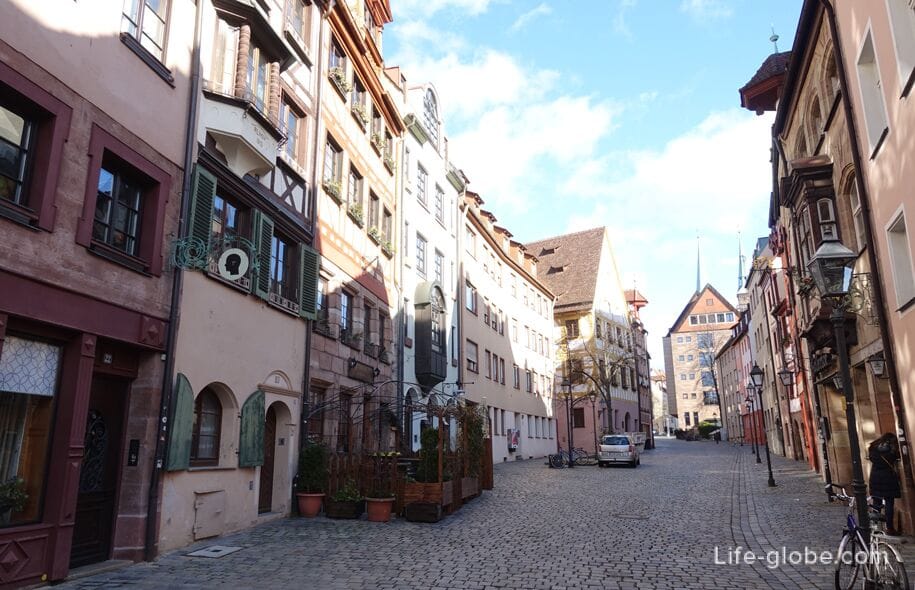
The Hallersches Haus was built in 1517 as an estate for the noble Nuremberg Haller family.
The exterior of the house is notable for the bay window, which was erected around 1720. The stepped pediment with scrolls and turrets is made in the German Renaissance traditions.
Today, the Nuremberg Toy Museum (Spielzeugmuseum) is located in the historic building, which is one of the most famous museums of its kind in the world.
The museum's collection displays the cultural history of toys from ancient times to the present day and contains about 87,000 exhibits, of which only a part can be seen on the museum's exhibition areas.
House address: Karlstraße, 13-15.
Toy Museum website: toy-museum. More about the toy house and museum...

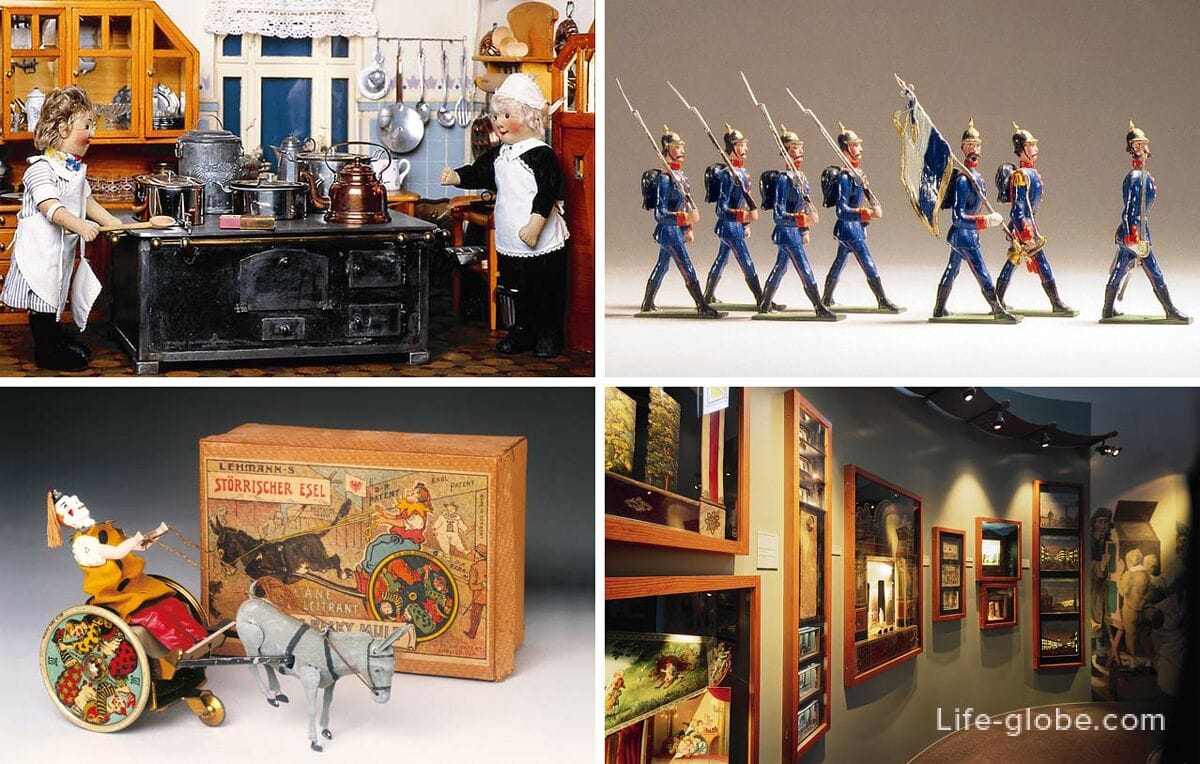
The German Museum of Nuremberg (Deutsches Museum Nürnberg) is the Nuremberg branch The German Museum of Masterpieces of Science and Technology in Munich (Deutsches Museum).
The museum has exhibitions dedicated to the following topics: work and everyday life, body and soul, system city, system earth and space and time.
The museum is informative and interactive.
Museum address: Augustinerhof, 4.
The museum's website: deutsches-museum.de/nuernberg .
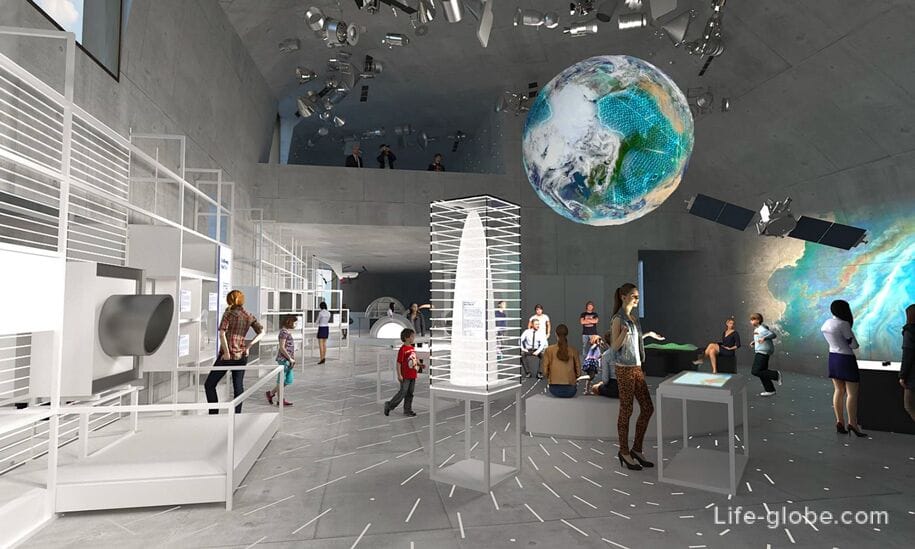
The Peller House (Pellerhaus), also referred to as the "Mayersches Pellerhaus" in relation to the post-war building, is a building that has an attractively restored historic ground floor and part of the courtyard integrated into the new building.
The building in the style of Italian palaces was built for Martin Peller according to the plans of architect Jacob Wolf the Elder from 1602 to 1605 on the site of the former estate.
During the Second World War, the Pellerhaus was almost completely destroyed. Subsequently, only the arched walls up to and including the first floor and partially the courtyard of the former outstanding mansion were preserved and reconstructed. In 1957 they were integrated into a new building.
The address of the Peller house: Egidienplatz, 23. More about the Peller House...
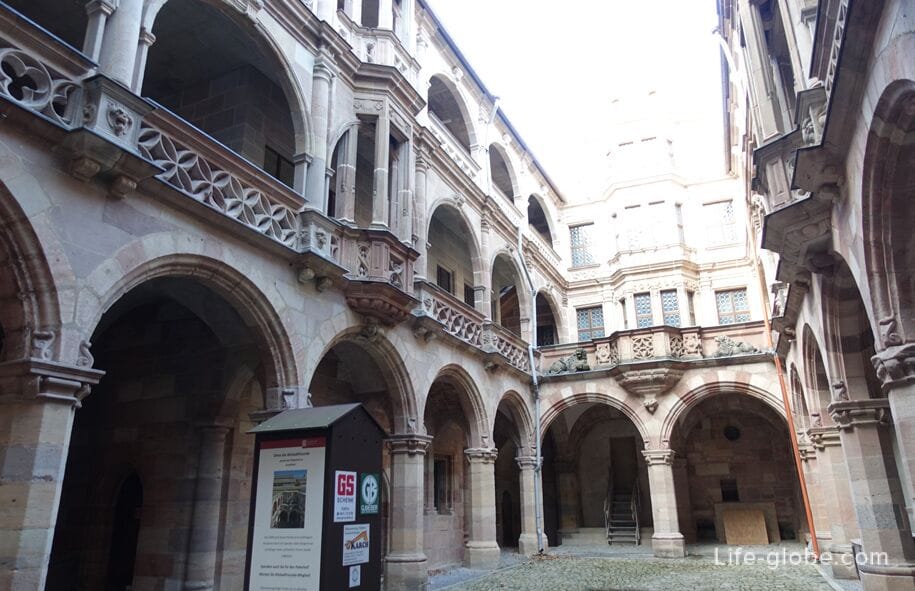
Tuchers Castle (Tucherschloss) is the historical residence of the noble patrician family of Tuchers.
The residence was built by Lorenz Tucher in 1533-1544, according to the designs, probably, of Paulus Boeheim, who designed the building based on the castles of the French Renaissance.
Today, a museum is located within the walls of the former residence. The castle garden is adjacent to the museum.
Castle address: Hirschelgasse, 9-11.
Museum website: tucherschloss. More about the Tuher Castle and the museum...
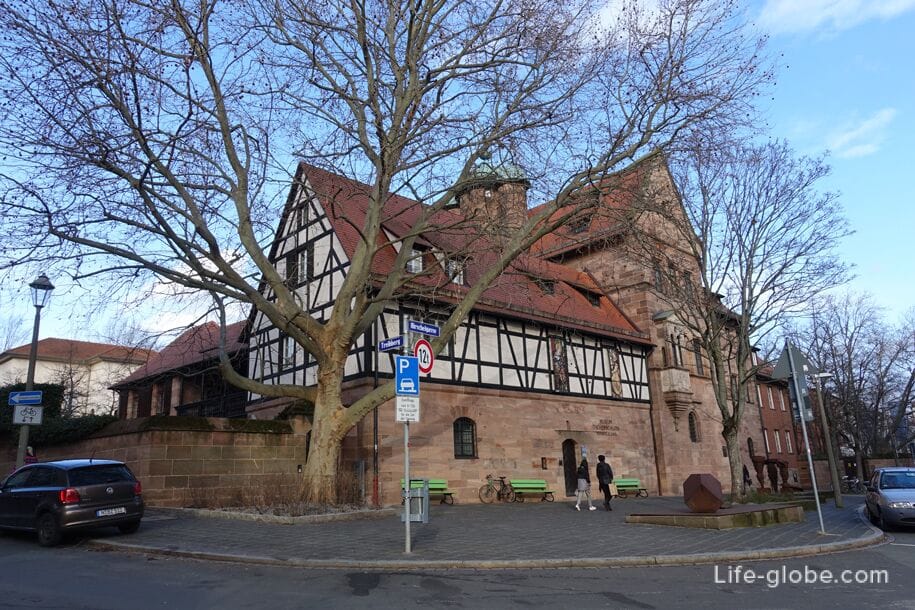
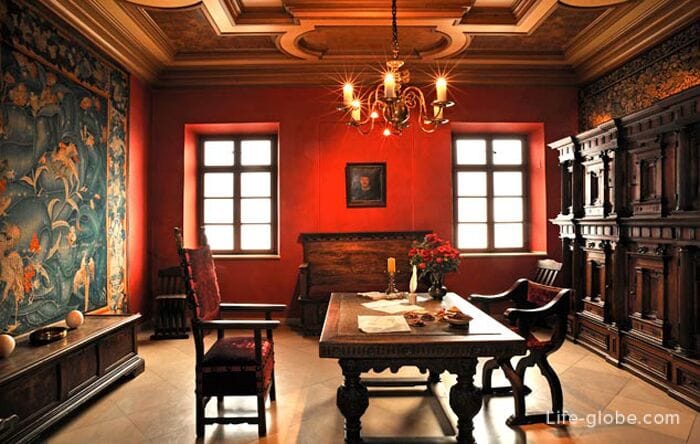
The Clock Tower or "Laufer Shock Tower" (Laufer Schlagturm) is a historical gate tower that was part of the penultimate city fortifications of Nuremberg and was also the gateway to the city.
The tower originally dates back to the 13th century and was probably erected in about 1250.
Today it is a tall tower with an arched passage, a clock, niches and a pointed roof, to which a fragment of the city defensive wall adjoins on the north side, and on the south - a building with a gable roof and three arched openings (passages), two of which are driveways.
The tower is located on Innerer Laufer Platz. Learn more about the Clock Tower and the adjacent ensemble...
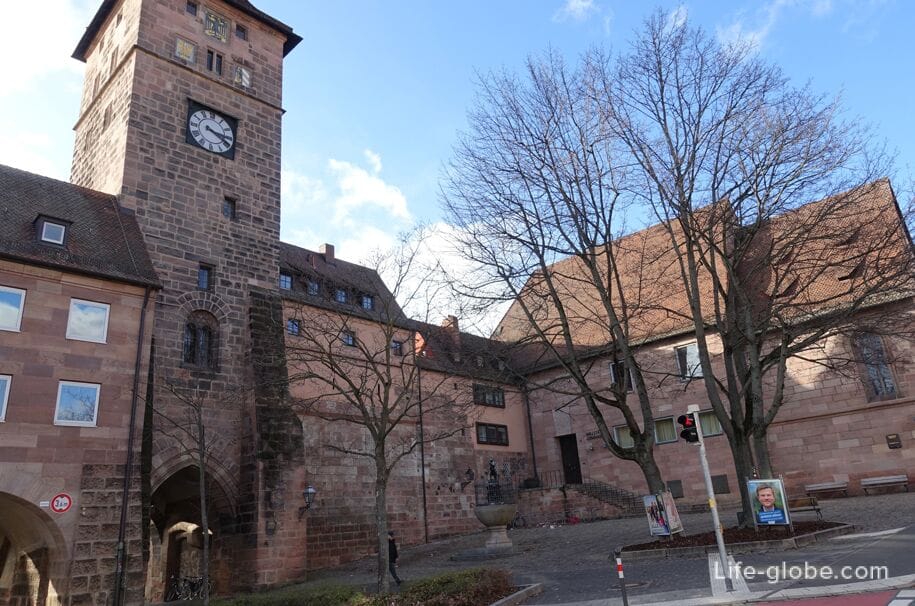
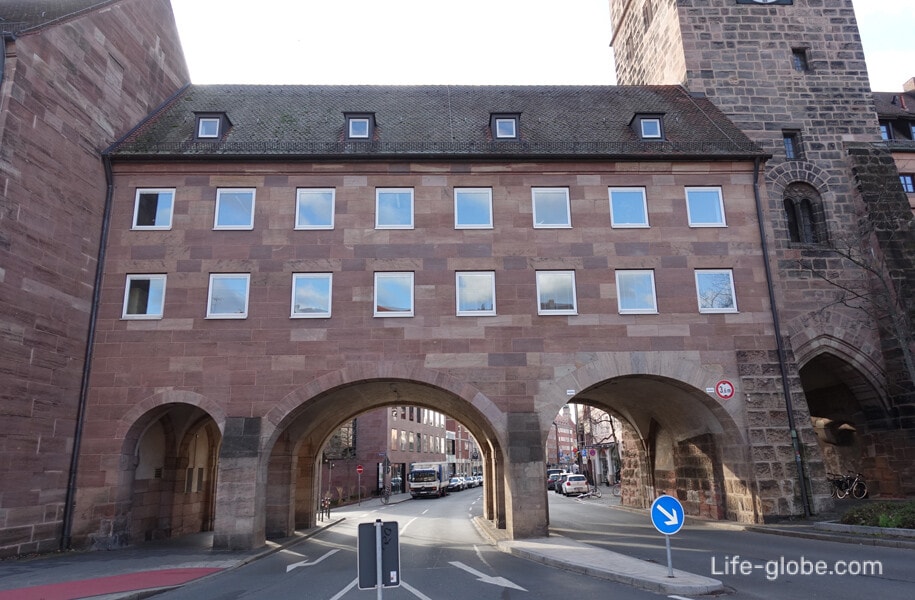
In addition to the above, there are other attractions in the old town of Nuremberg, including historical buildings, churches, fountains, museums, sculptures and monuments. Learn more about the old city of Nuremberg and its attractions...
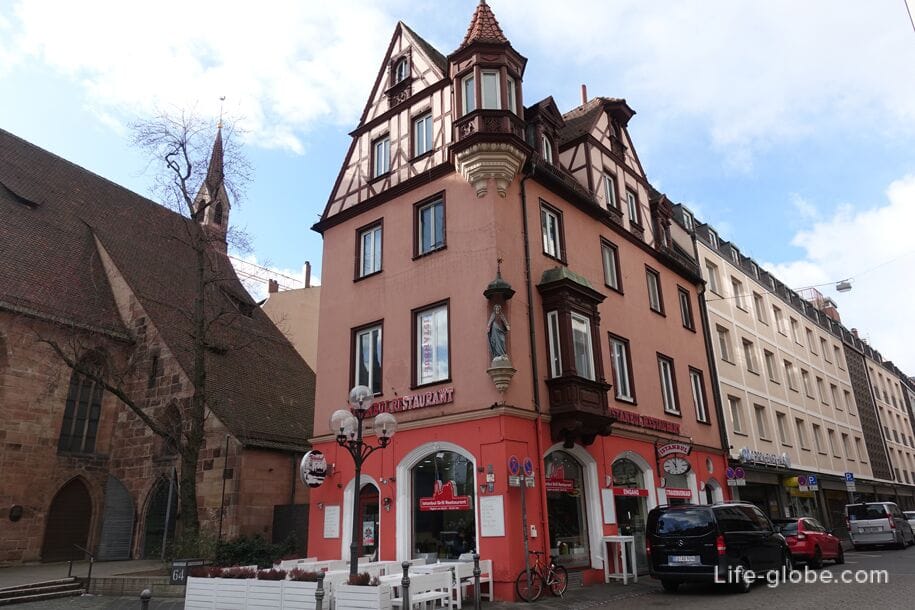
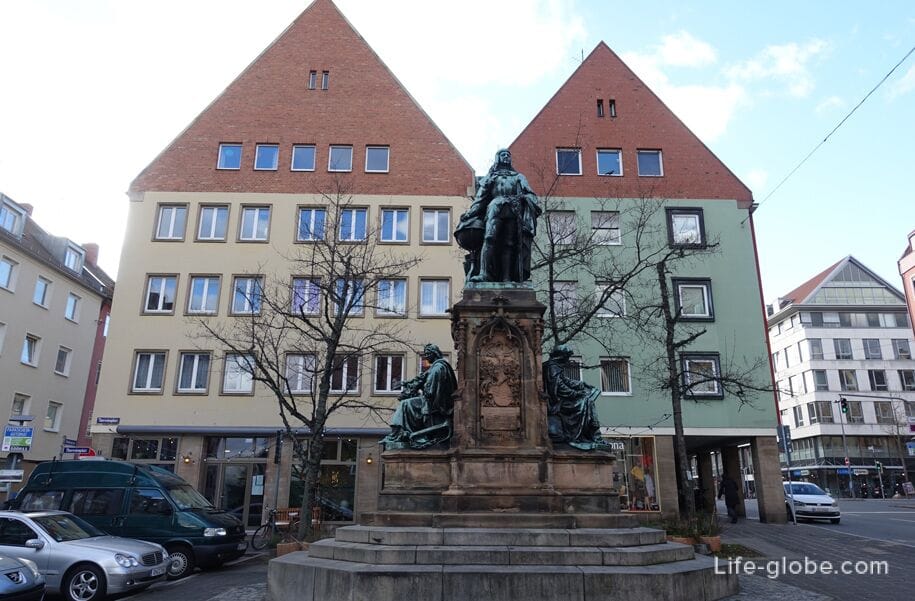
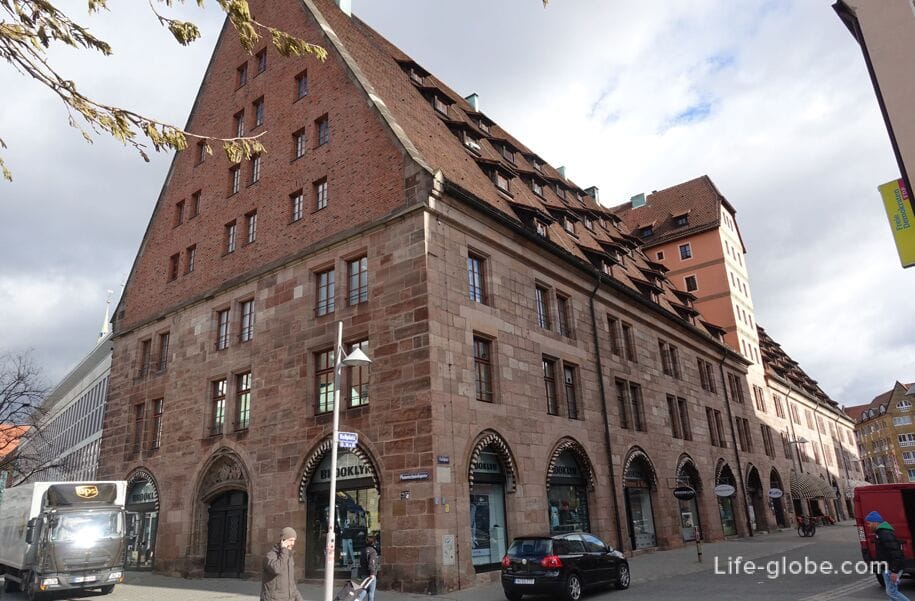
There are also important sights and museums outside the city walls of Nuremberg's old town.
The Hesperid Gardens (Hesperidengärten) were originally part of the green belt of gardens along the city walls. Such gardens were popular with aristocrats in the 16th and 18th centuries. Citrus fruits, vegetables and herbs were grown in the gardens.
Small ornamental gardens were built around the summer residences of the rich in both Renaissance and Baroque styles, and equipped with a large number of fountains and sandstone figures. Valuable and exotic collections of lime and bitter oranges were grown in luxuriously decorated gardens, lawns and flower beds were also arranged in the gardens.
The Hesperides Gardens are located to the west of the old town (outside the city walls) and has only a few preserved plots and relics of the former magnificent setting. The narrow and rectangular gardens are orthogonal and oriented from north to south. And the former dachas of patricians and merchants form the structural border of small territories.
Thus, the three combined gardens at the back of the houses on Johannisstrasse 43-47 and the garden behind the house on Johannisstrasse 13 are open to the public.
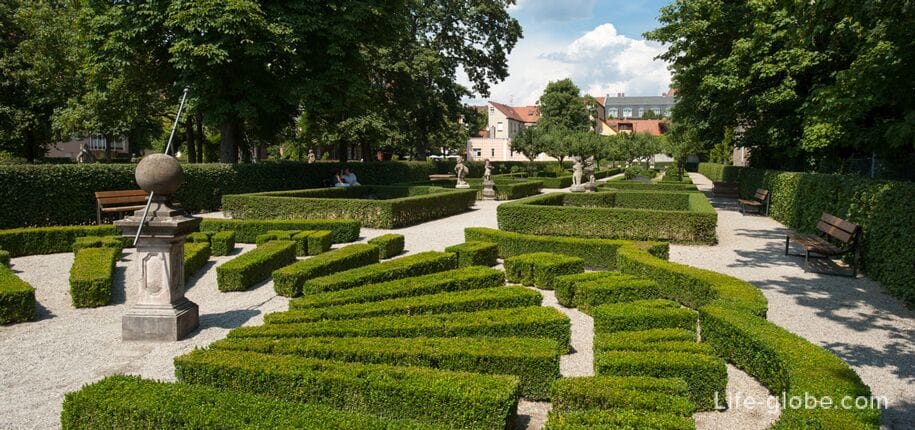
The cemetery of St. John and St. Rochus (Johannisfriedhof) is a medieval cemetery outside the city walls, which is officially considered the most beautiful cemetery in Germany.
The cemetery is known for elaborate epitaphs and some tombstones. Among other celebrities, Albrecht Durer is buried in the cemetery.
In the cemetery is the chapel of St. Rochus (Church of St. John). The choir was opened in 1377, and the nave in 1395, and the sacristy was added in 1446. Subsequently, the chapel was reconstructed.
Website: st-johannisfriedhof-nuernberg.
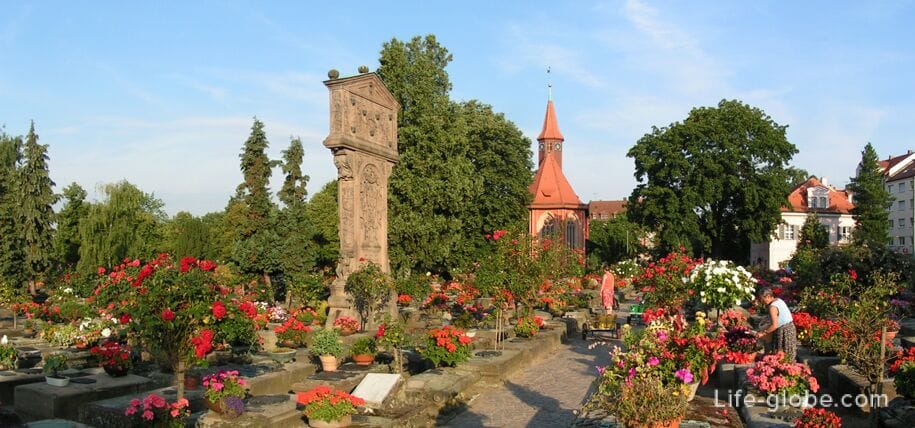
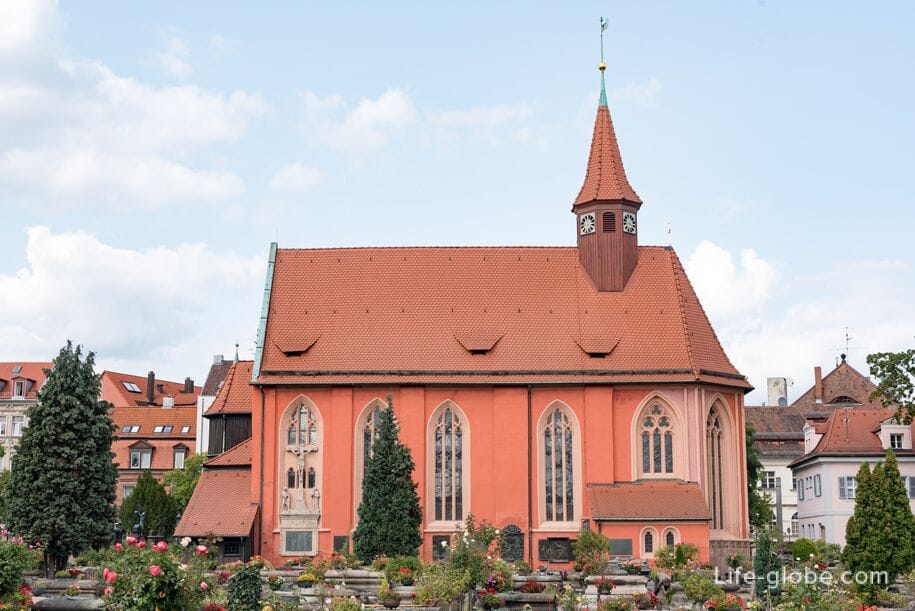
The Nuremberg Way of the Cross (Nürnberger Kreuzweg), also known as the Adam Kraft Way (Adam-Kraft-Kreuzweg), is a kind of example of the way of the Cross of Christ and has seven locations in the city of Nuremberg, created by Adam Kraft in 1506-1508.
The sculptor made to order seven steles depicting the way of Christ to Golgotha and inscriptions. The path led from the city walls and ended with a huge crucifix in the cemetery of St. John. Now the crucifix is in the courtyard of the Hospital of the Holy Spirit, and the original Steles have been replaced with copies.
The 1st stele is located at Burgschmietstraße 6;
2nd - Burgschmietstraße and the corner of Weigelstrasse;
3rd - Burgschmietstraße, in front of Kunstgießerei Lenz Art foundry;
4th - Burgschmietstraße and the corner of Campestraße;
5th - intersection between Burgschmietstraße and Johannisstraße;
6th - Johannisstraße and the corner of Rohledererstraße;
7th - east entrance to St. John's Cemetery.
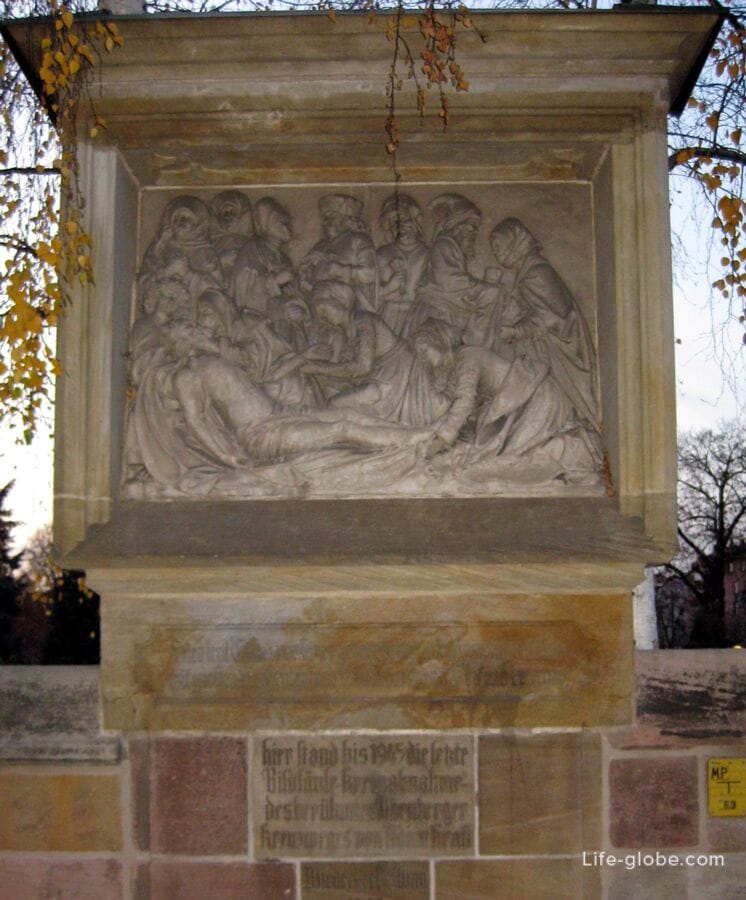
The Nuremberg Trial Memorial (Memorial Nürnberger Prozesse) is a museum of the history of the Nuremberg Trial, located in the Palace of Justice in Nuremberg, in the room where the trials of leading representatives of the National Socialist regime took place.
The museum includes:
- Hall 600, where in 1945-1949 the Nuremberg trials of prominent representatives of the political, military, judicial and economic leadership of Nazi Germany who planned, committed or otherwise participated in the Holocaust and other war crimes took place;
- a permanent exhibition that provides information about the history, participants, the course and consequences of the trial, the prosecution of Nazi crimes after 1946.
Museum address: Bärenschanzstraße, 72.
Museum website: memorial-nuernberger-prozesse. More about the Museum of the History of the Nuremberg Trials...
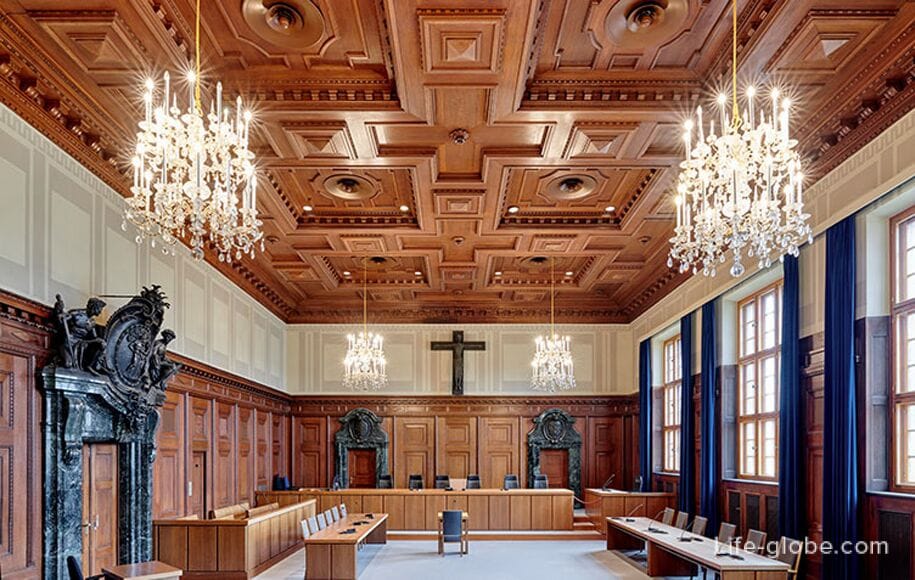
Nuremberg City Park (Stadtpark Nuremberg) is a green area in the center of Nuremberg, where there are: alleys for walking, places to relax, flower beds, several monuments, vases, a restaurant, a lake and the famous fountain of Neptune.

The Neptune Fountain (Neptunbrunnen) is the main decoration of the park and the largest Baroque fountain north of the Alps.
The fountain was created by Nuremberg master sculptors X. Ritter, G. Schweiger and I. Eisler in 1660-1668 as a memorial to peace after the end of the Thirty Years' War.
In 1797, the city sold the fountain of Neptune to the Russian Emperor Paul I, who sent it to the city of St. Petersburg and installed it in The upper garden of the Grand Peterhof Palace in Peterhof.
In the park in Nuremberg there is a copy of the fountain, created from plaster casts in 1896-1902. Learn more about Nuremberg City Park and Neptune Fountain...

The Reformation Memorial Church (Reforms-Gedächtnis-Kirche) is a striking landmark in the northern part of Nuremberg and its round building with three towers is clearly visible from afar.
The church building was laid on June 11, 1935. The consecration took place on November 6, 1938. Two years later, a meeting house was opened opposite.
The church was badly damaged during the Second World War. Since 1945 it has been rebuilt and reopened in 1949.
There is an organ in the church; organ concerts are held.
Church address: Berliner Platz, 11.
Website: maxfeld-evangelisch.
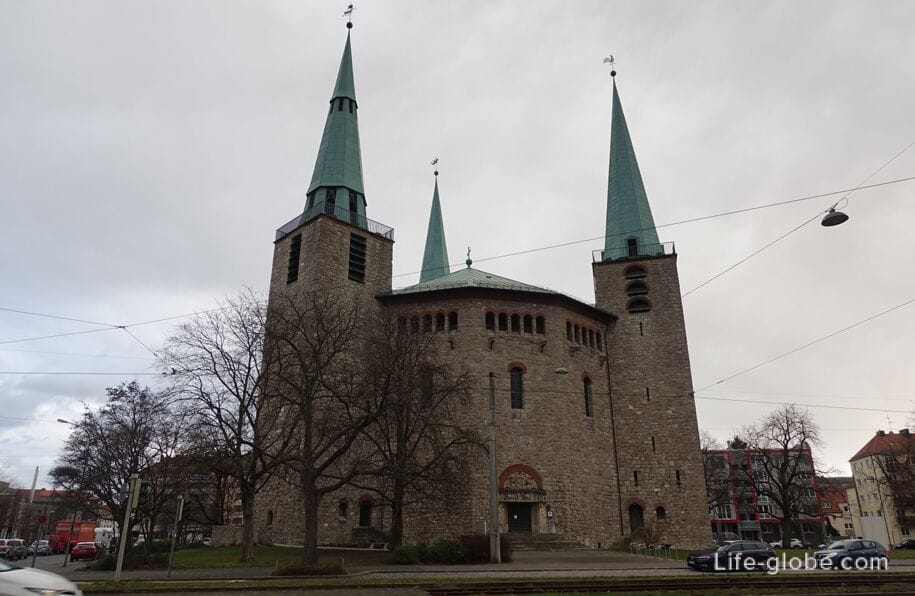
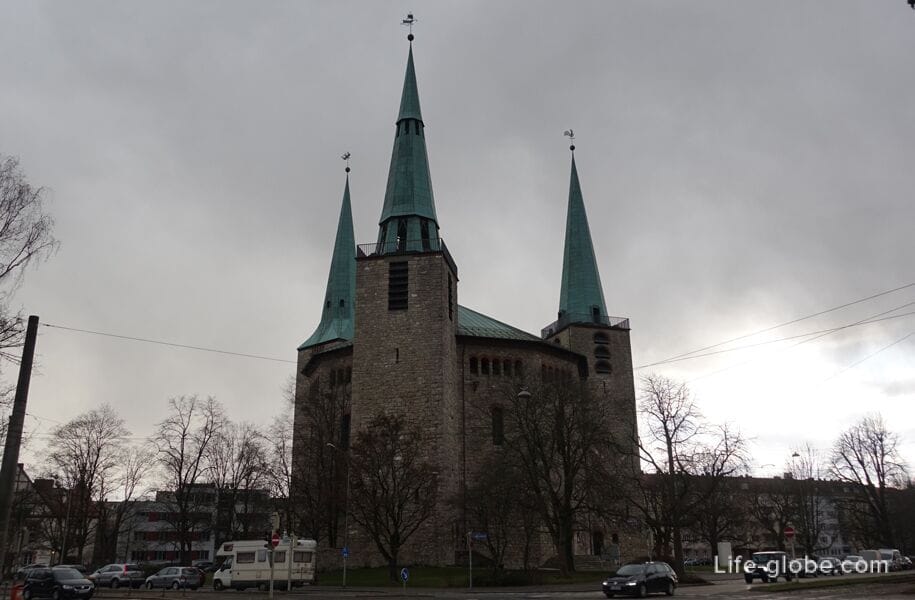
The State Theater of Nuremberg (Staatstheater Nuremberg) is one of the largest diversified theaters in Germany, the building of which is a complex consisting of old and new parts.
The theater was built from 1901 to 1905 in the Art Nouveau style and then it was the Nuremberg Opera House (Opernhaus Nürnberg).
In 1959, the theater building was expanded thanks to the addition of the dramatic chamber theater, which became part of the architectural complex of the state theater.
Today, the "old" neoclassical with groups of sculptures and mosaics, and the "new" theater buildings represent a single theater complex.
Theater address: Richard-Wagner-Platz, 2-10.
Theater website: staatstheater-nuernberg. More about the Nuremberg State Theater...
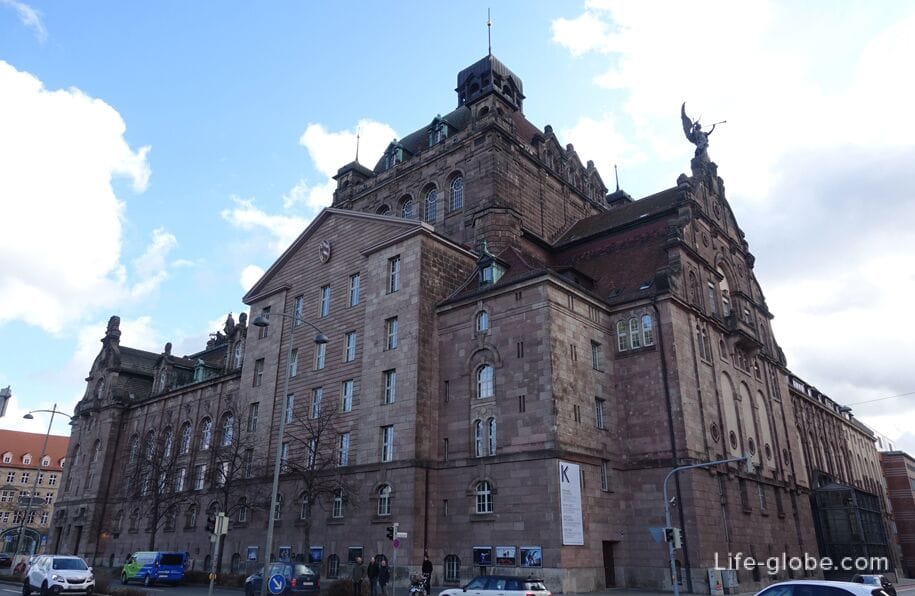
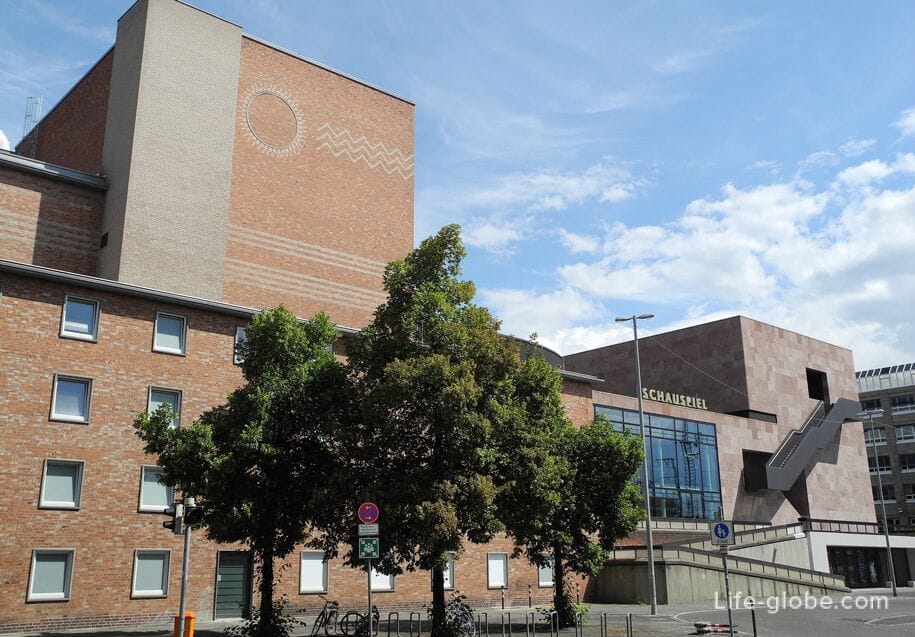
The Nuremberg Transport Museum (Verkehrsmuseum Nürnberg) was founded at the end of the 19th century and is one of the oldest museums of technical history in Germany. It has interactive exhibits, models and original trains.
The Nuremberg Transport Museum consists of the Museum of German Railways (Deutsche Bahn) and the Museum of Communications (Museum für Kommunikation), located in a historic building in the center of Nuremberg.
Museum address: Lessingstraße 6.
Sites: dbmuseum; mfk-nuernberg. More about the Nuremberg Museum of Transport...
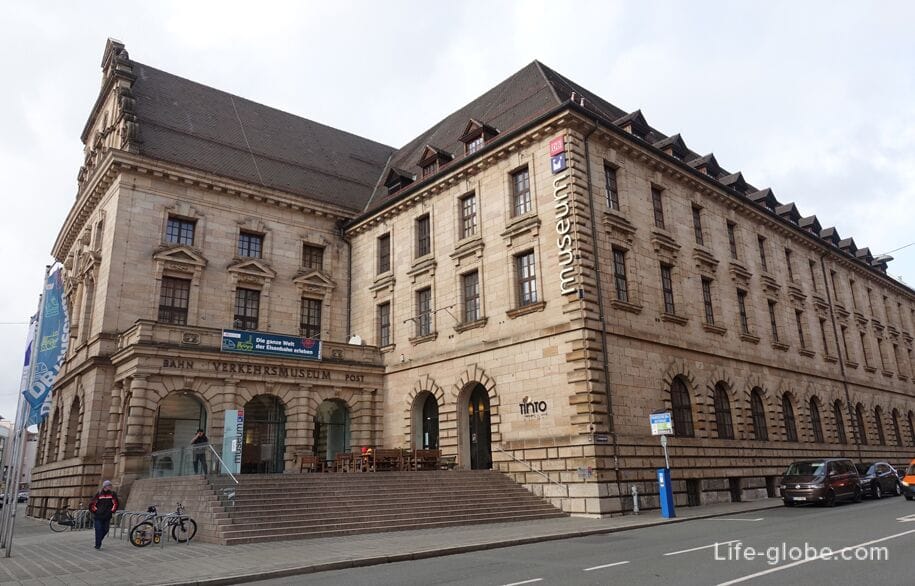
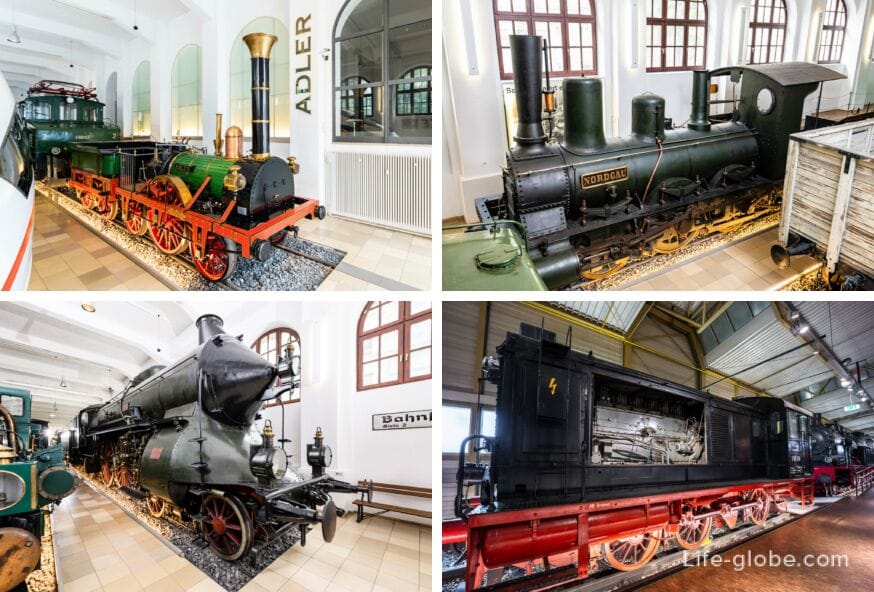
The Museum of Industrial Culture (Museum Industriekultur) is an interactive museum of technology, culture and social history, which shows the history of industrialization on the example of Nuremberg from 1800 to the present day.
The museum was established in 1988 in the building of a former metallurgical plant and occupies about 6000 m2 of exhibition space.
In the museum: historically decorated premises, including residential, a printing house, a grocery store, a dental office, a theater, etc.; items related to industry and high-speed sports - running, cycling and motorsport.
The museum also includes a block "Motorcycle museum" (Motorradmuseum), dedicated to the former largest motorcycle manufacturer in Nuremberg - the Zündapp factory. Here you can see world record cars, prototypes, single copies and test models.
The museum is complemented by the permanent exhibition of the school museum (Schulmuseum).
The museum hosts various events and concerts.
The address of the museum is: Äußere Sulzbacher Straße, 62.
Museum website: museum-industriekultur.
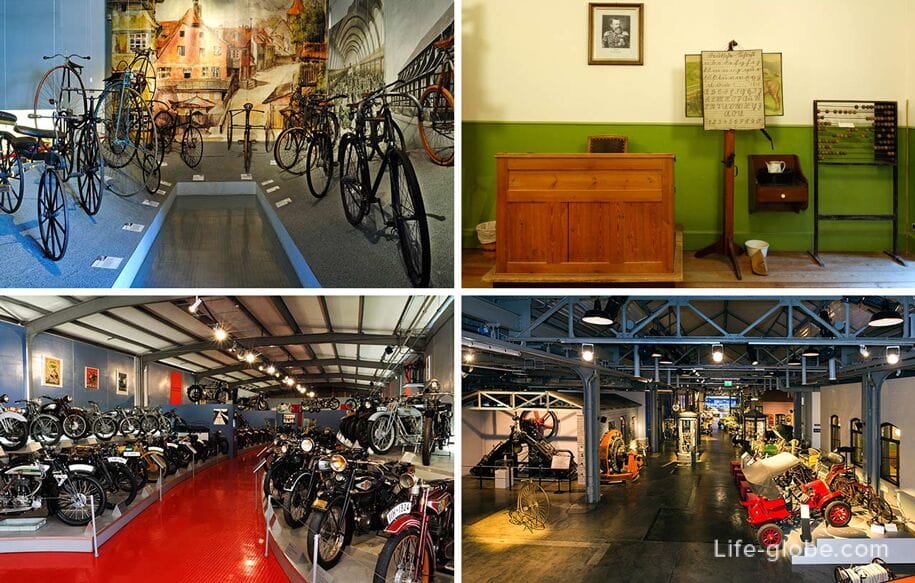
The Merks Motor Museum (nostalgia and vintage) is an automobile museum that presents a private collection of classic cars.
The exhibition covers about 90 cars, including motorcycles - all from the former Nuremberg production lines. Along with cars, there are other small exhibitions, for example, old radios, 1950s kitchen, Triumph typewriters and more.
Museum address: Merks Klingenhofstraße, 51.
Museum website: merks-motor-museum.

The Nuremberg Zoo (Tiergarten Nürnberg) is among the best European zoological parks.
The zoo is home to manatees, sloths, turtles, butterflies, monkeys, beavers, otters, penguins, sea lions and other animals. The zoo's inhabitants represent many continents of the world.
The zoo has a contact area and a children's playground.
Address of the Nuremberg Zoo: Am Tiergarten, 30.
Nuremberg Zoo website: tiergarten.nuernberg.

The Documentation center of the territory of the party congresses or the Documentation center of the NSDAP Party congresses (Dokumentationszentrum Reichsparteitagsgelände) is a museum located in the northern wing of the unfinished new Congress Palace on the former territory of the party congresses, designed in the project for 50 thousand spectators. In the Third Reich, Nuremberg was the "city of the NSDAP party congresses", where from 1933 to 1938 the National Socialists held meetings of the Nazi Party.
The permanent exhibition tells about the origins, content and consequences of the National Socialist totalitarian regime. The central theme of the sections of the exposition organized in chronological order is the history of the NSDAP party congresses, at which ostentatious "unity of the nation" was demonstrated in the form of mass events for the purposes of National Socialist propaganda.
The exhibition also includes stands containing information about the history of each object on the territory of the NSDAP party congresses.
The Documentation Center regularly hosts special thematic exhibitions and training programs for people of different ages.
The address of the center: Bayernstraße, 110.
Museum website: dokuzentrum.
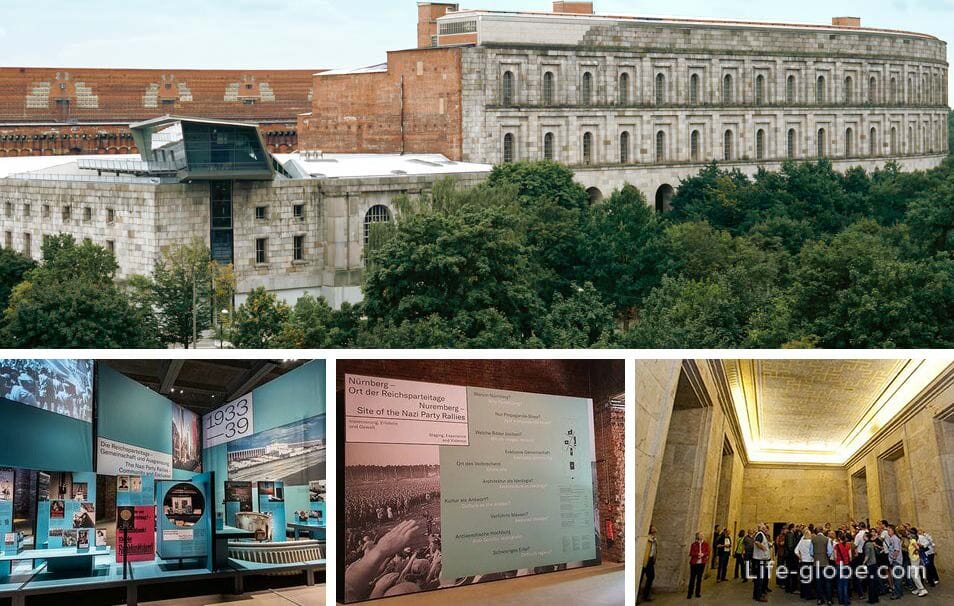
Next to the Documentation centre are: the Temple of Memory (Ehrenhalle) with the adjacent Park - the memorial to the fallen in the First world war, mounted in 1928-1929; concert hall Meistersingerhalle; lake Zilber (Silbersee) with the adjacent Park and panoramic hill; Fairgrounds NürnbergMesse GmbH, where international trade fairs, congresses and other industry events.
Kunstvilla (Kunstvilla Nürnberg) is a former merchant's mansion built in the neo-Baroque style by architects Heinrich Theodor Schmidt and Georg Richter between 1893 and 1895.
The two-storey building with a mansard roof, stands on a high ground floor and is lined with sandstone, also has several risalits and balconies.
Today, the carefully restored building is an architectural monument and within its walls there is an art museum with exhibitions dedicated to presentation, communication and research of regional art history. The museum shows thematic and monographic exhibitions of 20th and 21st century art from city funds, as well as from public and private collections.
Villa address: Blumenstraße, 17.
The museum's website: kunstkulturquartier.de/kunstvilla .
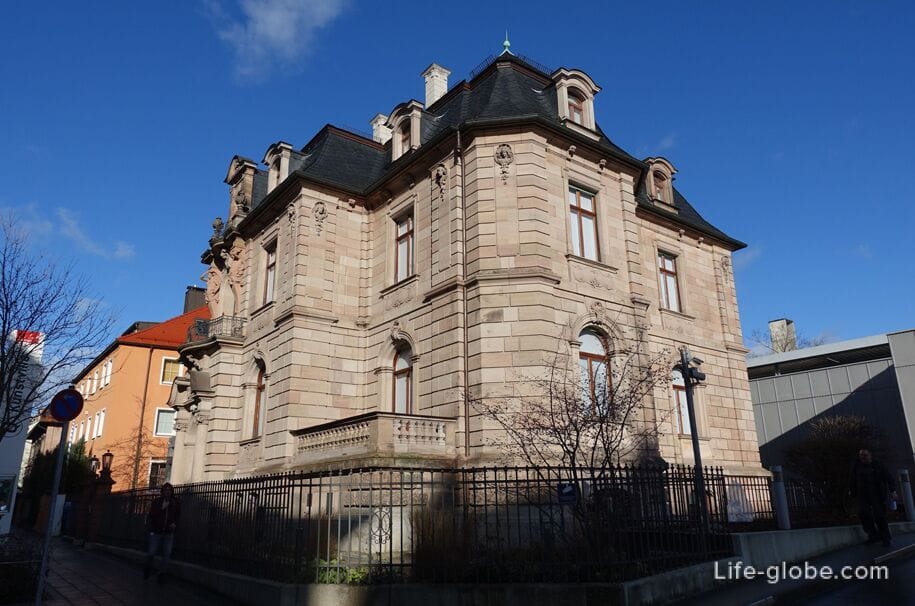

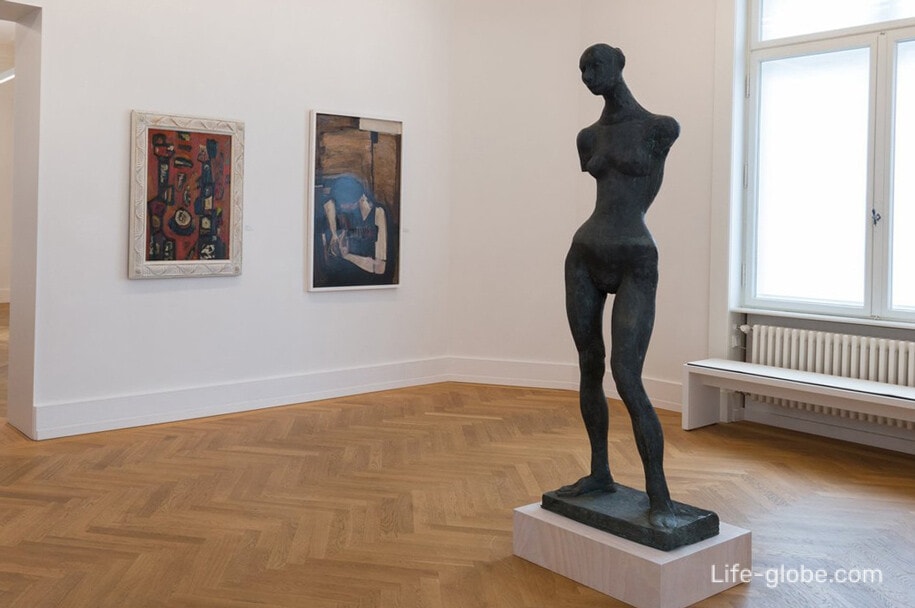
Other historic buildings are also notable in the area surrounding Kunstville.
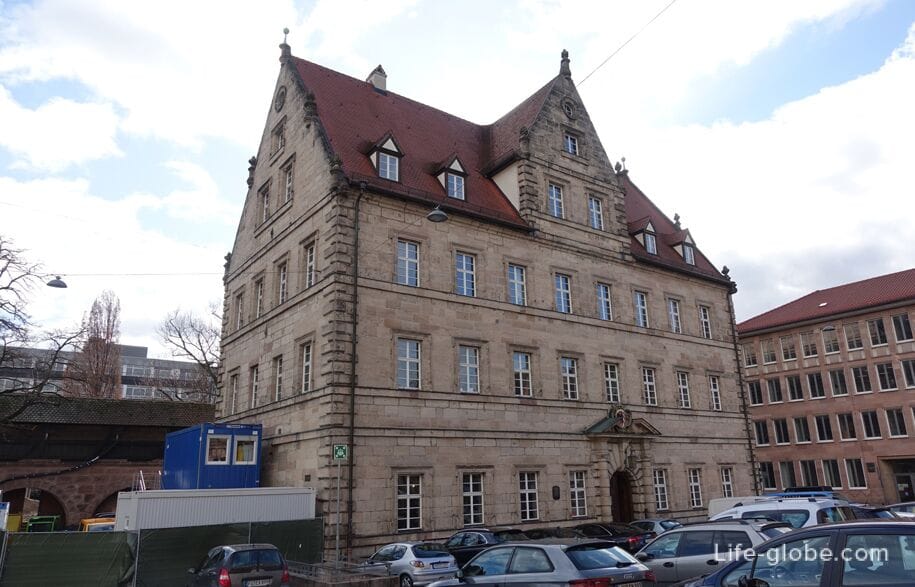
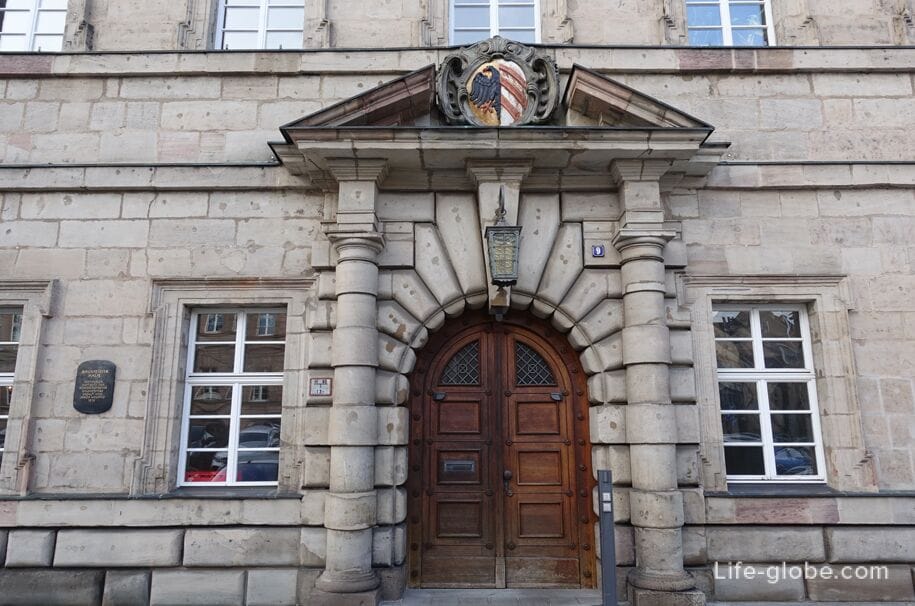

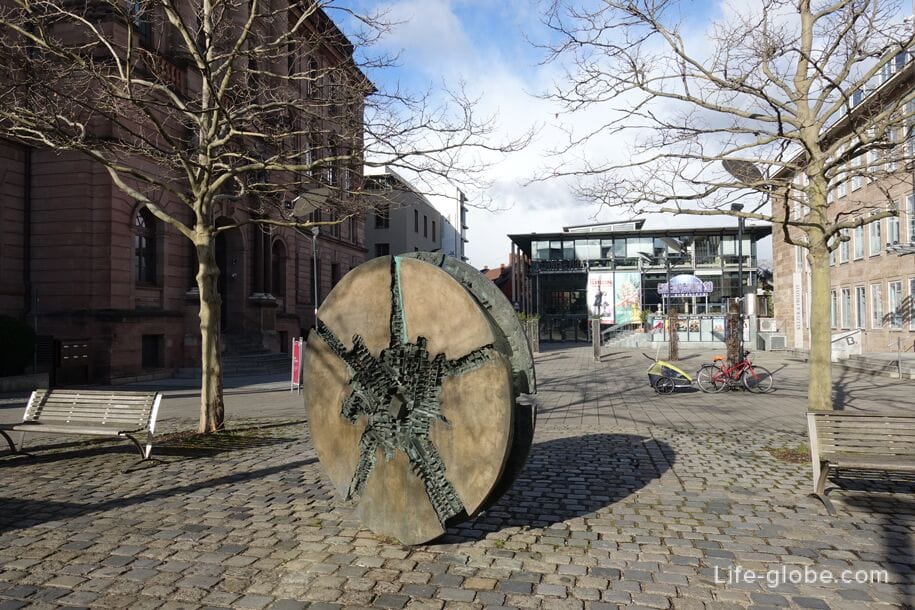

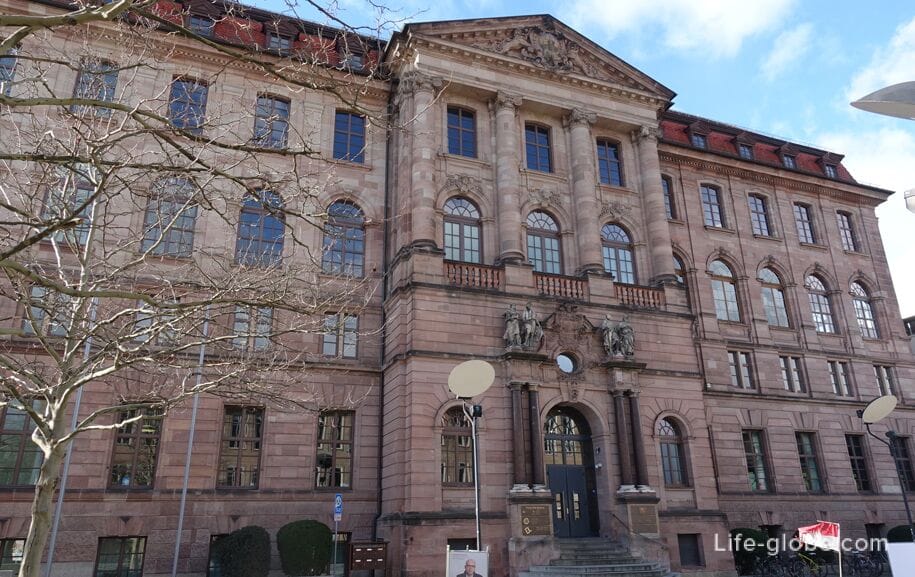
Nicolaus Copernicus Planetarium is the only major planetarium in Bavaria. Together with the Nuremberg Educational Center (Adult Education Center) and the Nuremberg City Library, the Planetarium forms the Nuremberg Educational Campus.
Because of its synagogue-like architecture, Nuremberg's first planetarium on Rathenauplatz, which was officially opened on April 10, 1927, was demolished during the Third Reich and rebuilt after the war in its new current location.
The dome of the planetarium is 18 meters wide.
The address of the planetarium: Am Plärrer, 41.
Planetarium website: planetarium-nuernberg.
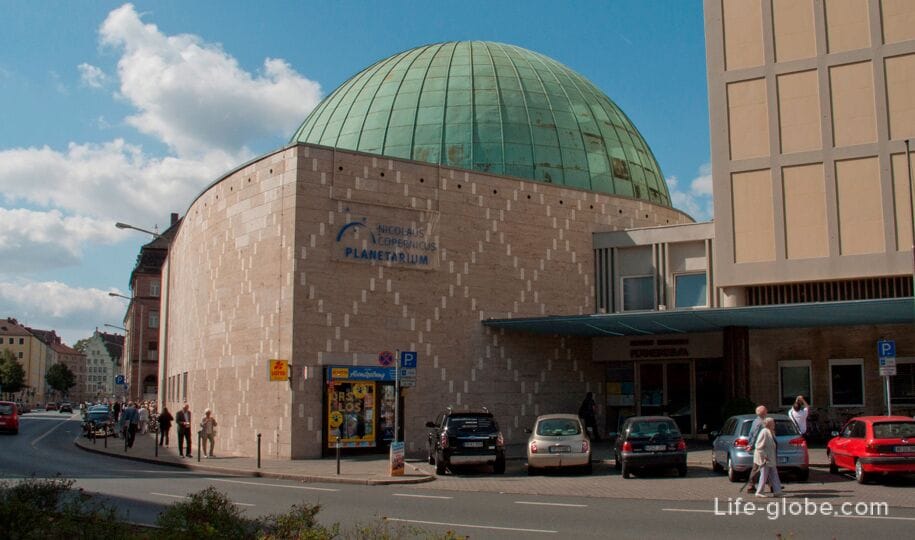
The Volksbad Nürnberg indoor swimming pool attracts attention with its historic building, which was built between 1911 and 1913 and is considered the pearl of the Art Nouveau bathing culture in the city.
The architecture of the building is notable for the columns of the portico at the entrance with the coat of arms of the city.
Pool address: Rothenburger Strasse, 10.
Pool website: volksbad.
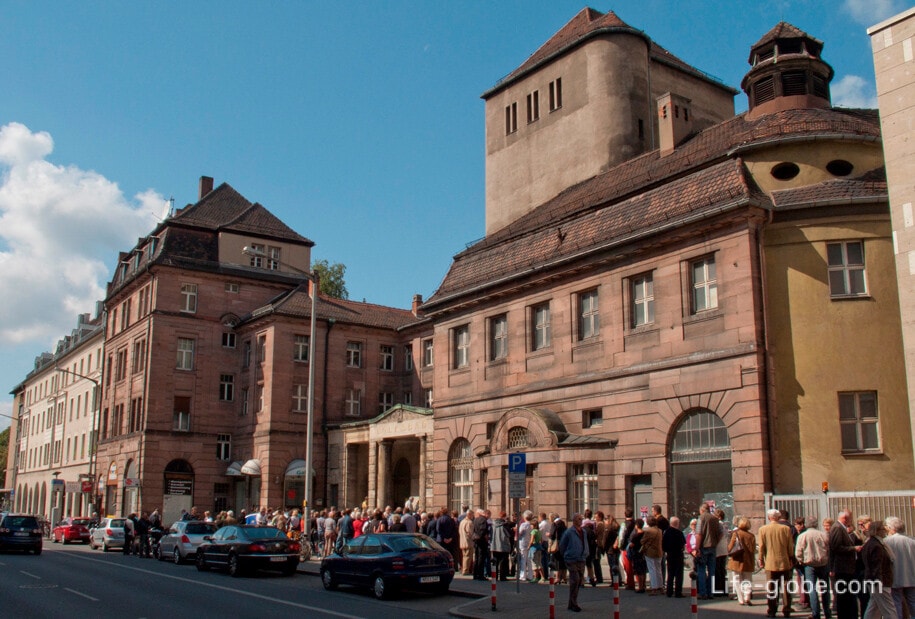
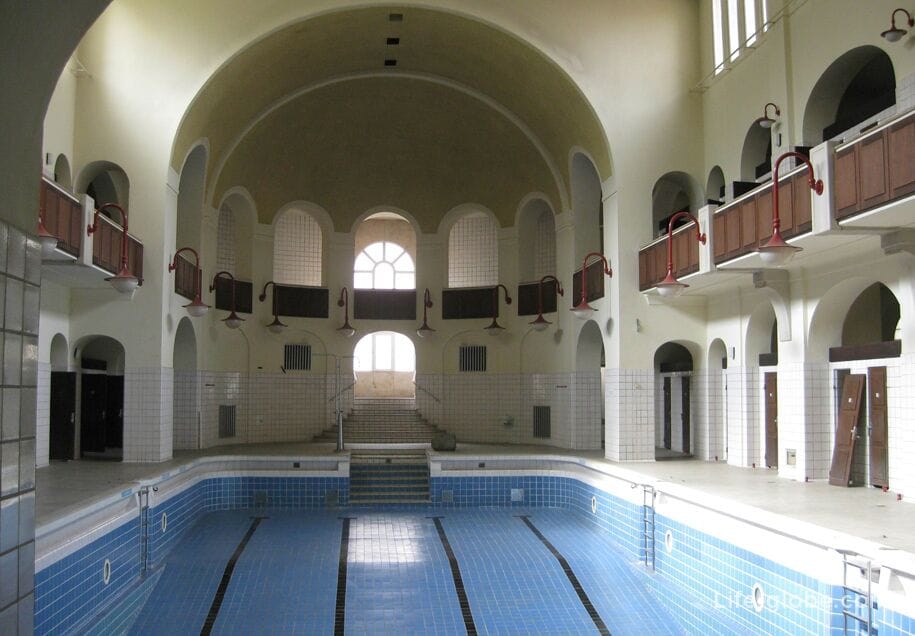
The Nuremberg Telecommunications Tower (Fernmeldeturm Nuremberg), which, because of the egg-shaped tower part, also bears the unofficial name "Nuremberg Egg", is the tallest building in Nuremberg and one of the tallest in Bavaria.
The tower was built between 1977 and 1980 and is now listed as a monument in Bavaria.
The total height of the tower is 293.80 meters. The height of the tower cage is almost 50 meters, and the diameter is 32 meters.
There are three rotating white beacons on the roof of the tower, which are offset by 120 degrees and shine in two directions; they can be turned on and off from the tower at Nuremberg Airport, and they are used for orientation and flight safety.
The address of the tower: Hansastraße, 7A.
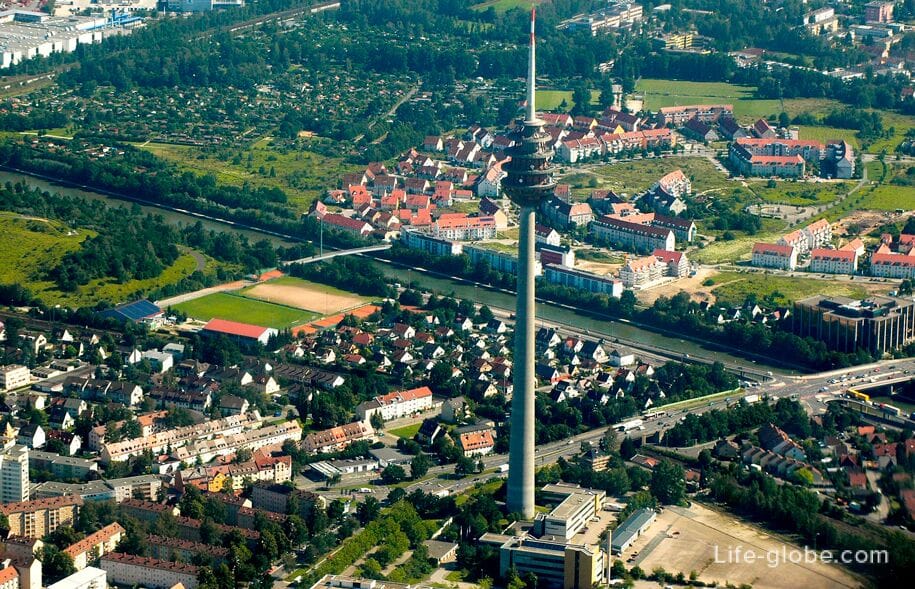
The Nuremberg Business Center (Business Tower Nürnberg) is an office building in Nuremberg and the headquarters of the general management of the Nürnberger Versicherung.
After the Nuremberg Telecommunications Tower, it is the second tallest 34-storey building in Nuremberg, as well as one of the tallest skyscrapers in Germany.
The height of the Business Center is 135 meters and is an integral part of the Nuremberg silhouette. The offices in the tower offer stunning views of the city.
The address of the Business center: Ostendstraße, 100.
Website: businessstower.
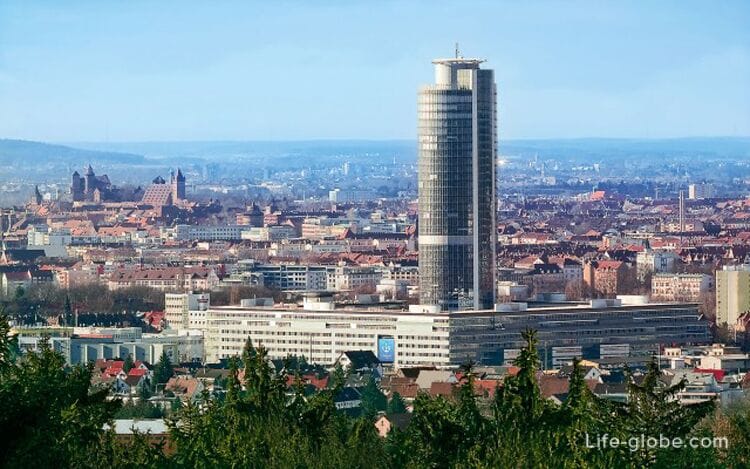
The original tower (Quelleturm) is a 90-meter advertising tower in Nuremberg, which was built in 1964 from a chimney.
In the spring of 2006, the tower was included in the list of monuments of the city of Nuremberg.
Inside the tower there are two brick chimneys - there used to be three - and an elevator. After switching to district heating around 2000, the tower was used only for advertising purposes.
The address of the tower: Wandererstraße, 89.

For the convenience of visiting the sights and museums of Nuremberg, you can purchase a Nuremberg card (NÜRNBERG CARD + FÜRTH) with which you can visit some museums and attractions for free. Free public transport is also included.
In Nuremberg, you can take a hop-on hop-off tour bus or a sightseeing train to the sights of the city.
You can view the cost and buy tourist maps, tour bus routes and buy tickets, as well as other excursions, tours and tickets in Nuremberg here →
All accommodation facilities in Nuremberg, including in the historical center of the city and more remotely from it, can be viewed and booked here